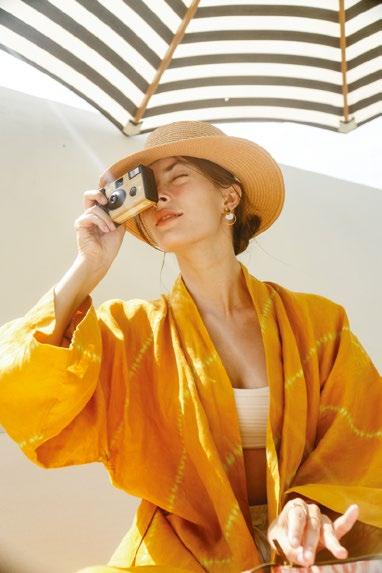
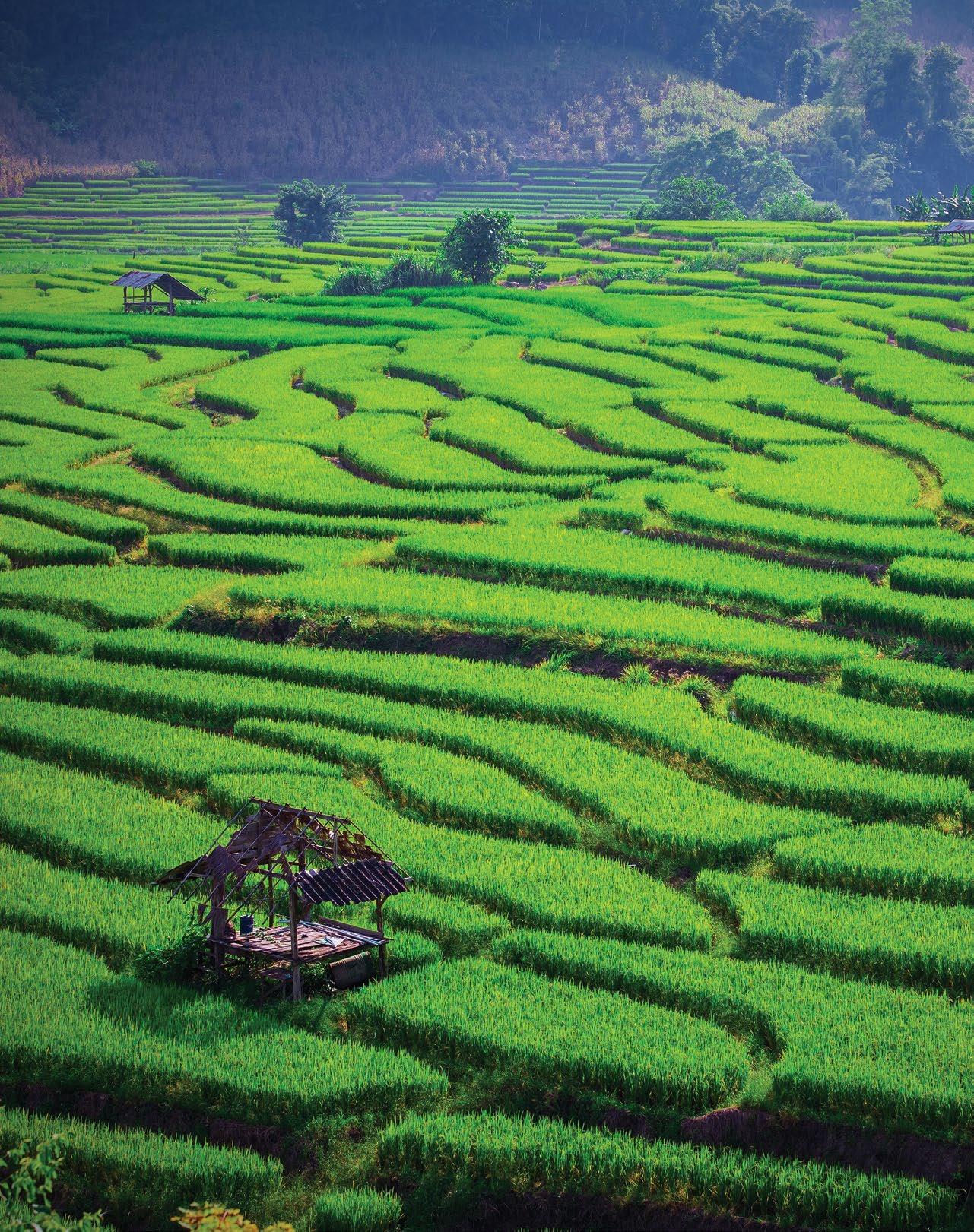


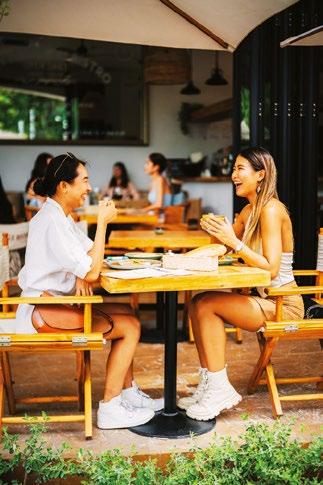















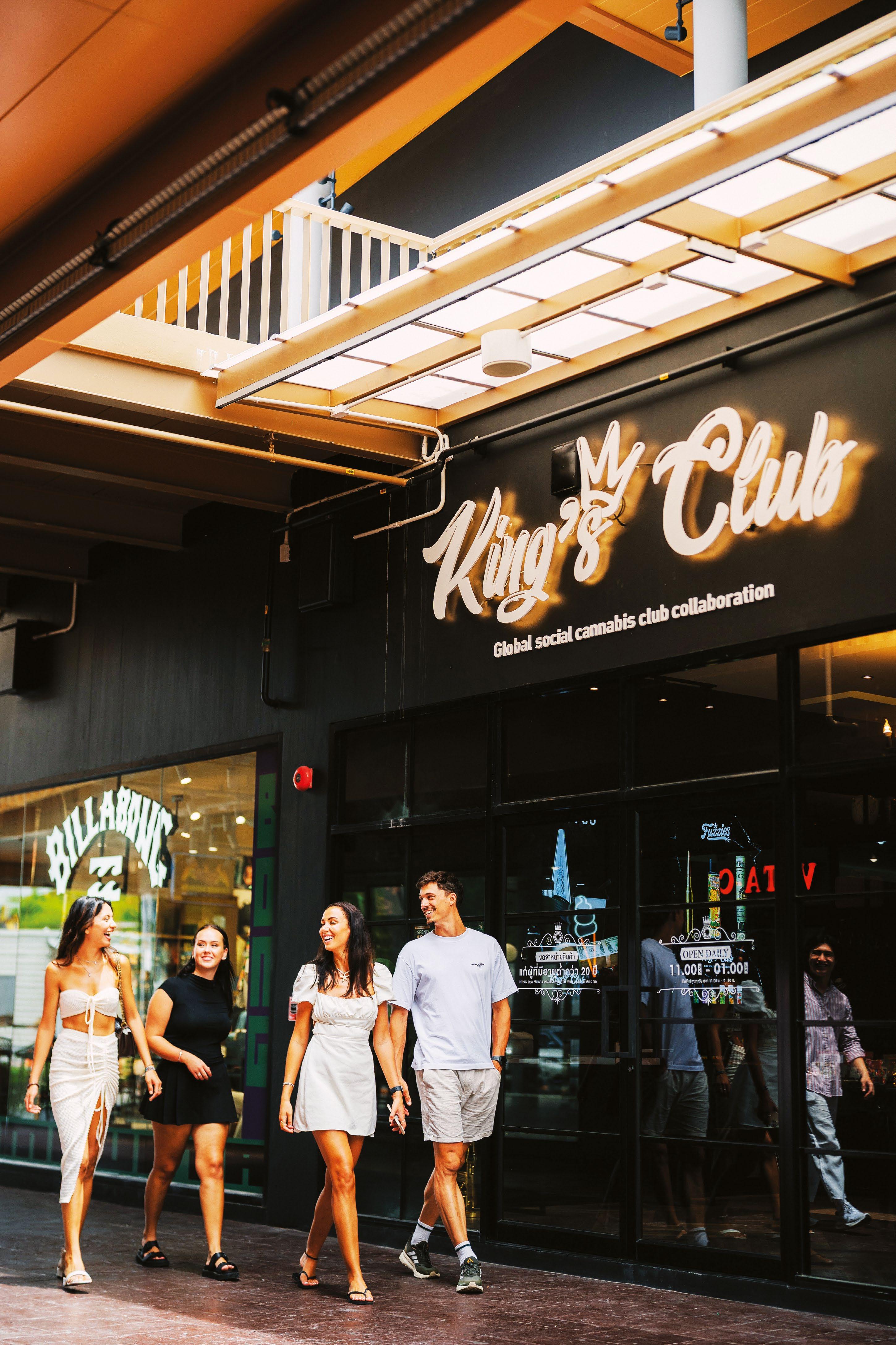









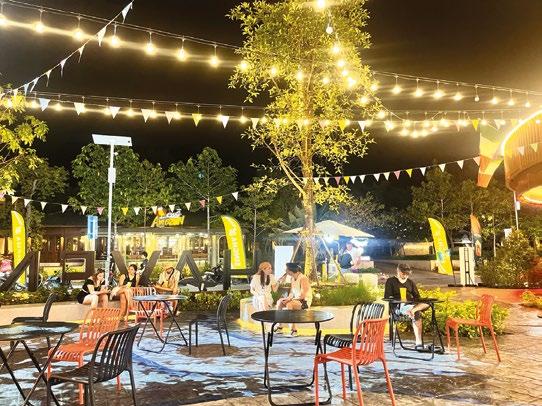

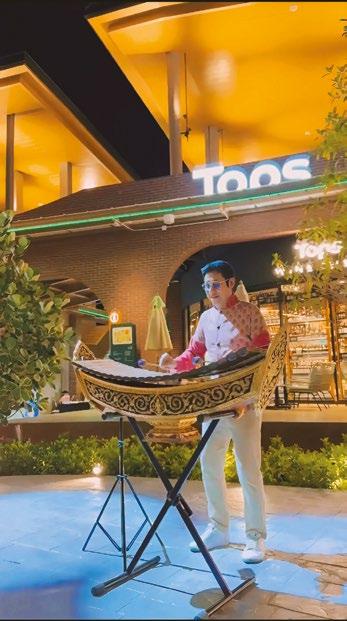



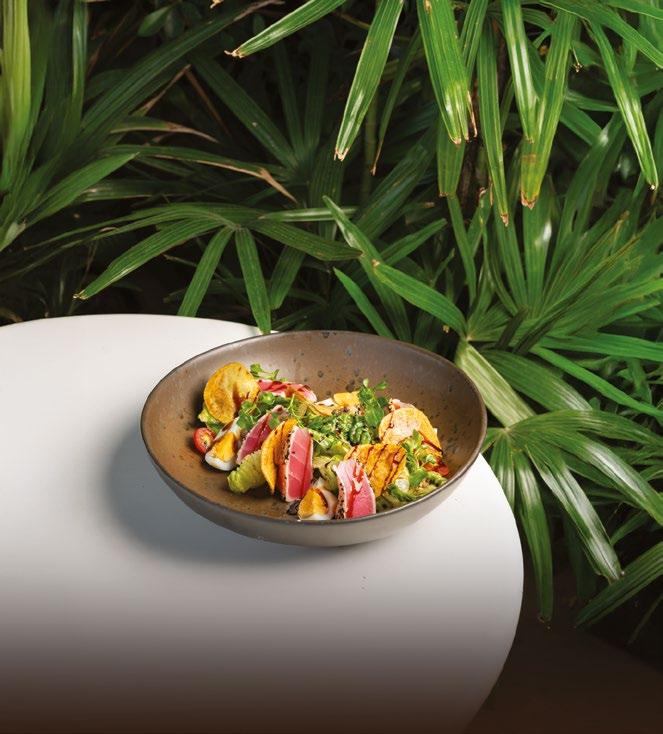
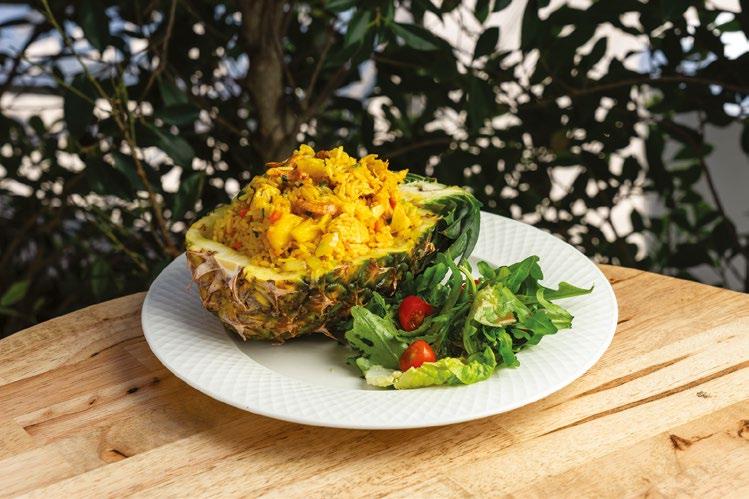
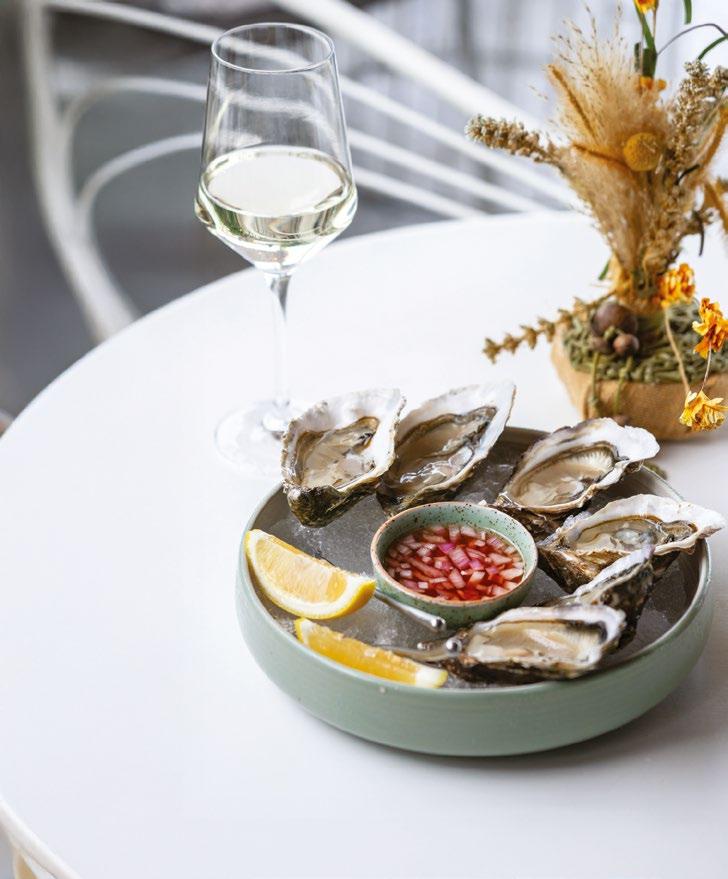

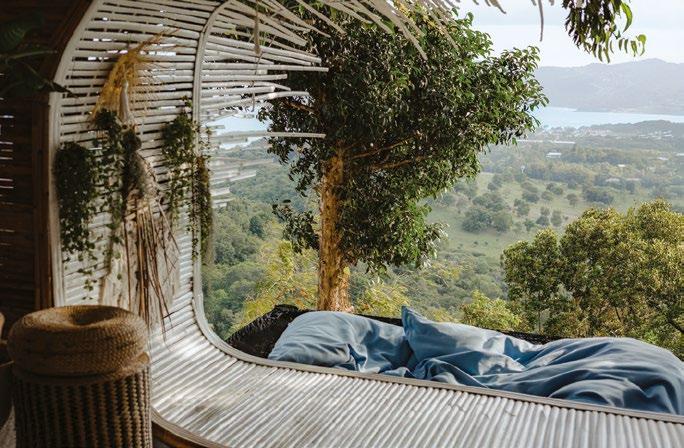
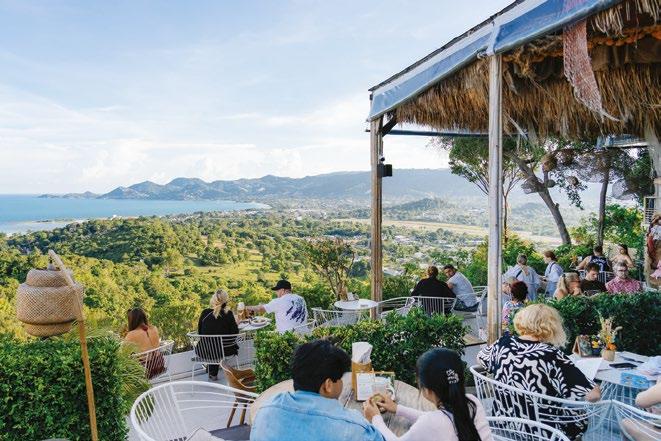




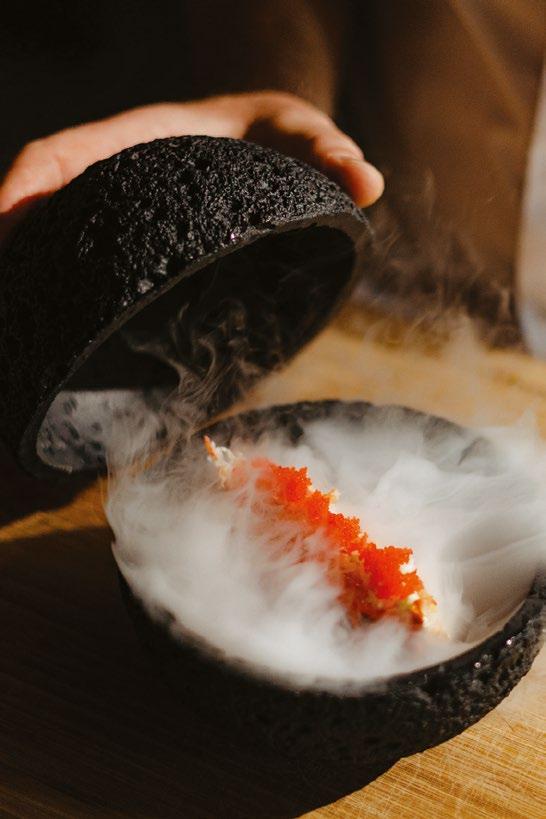
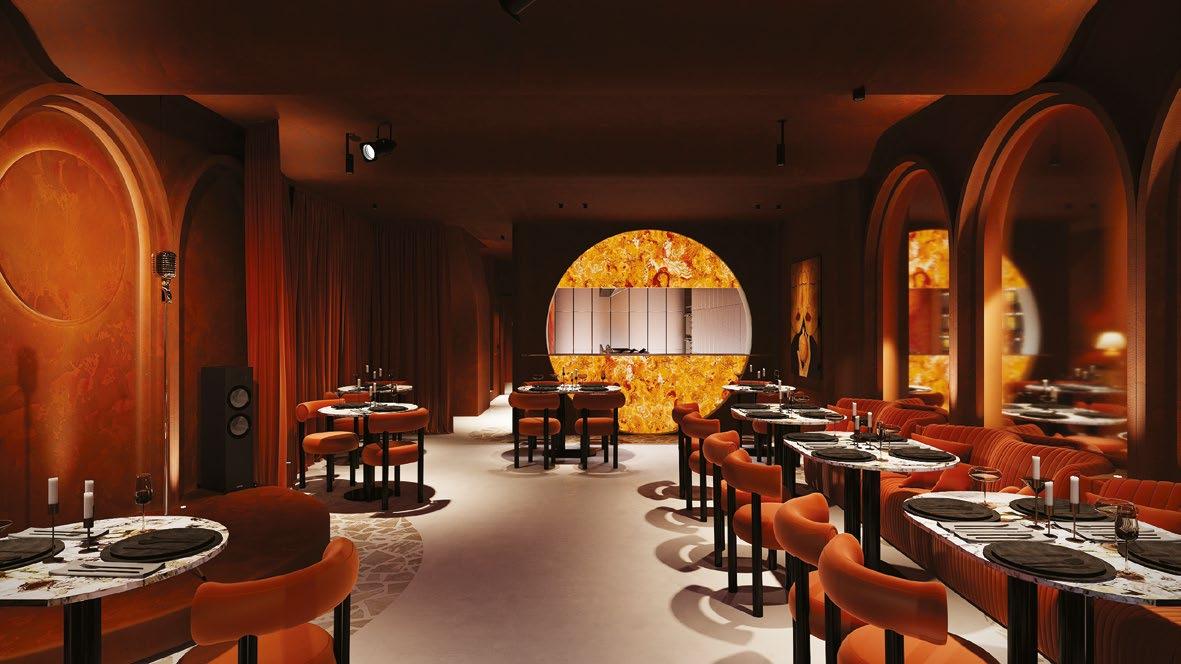





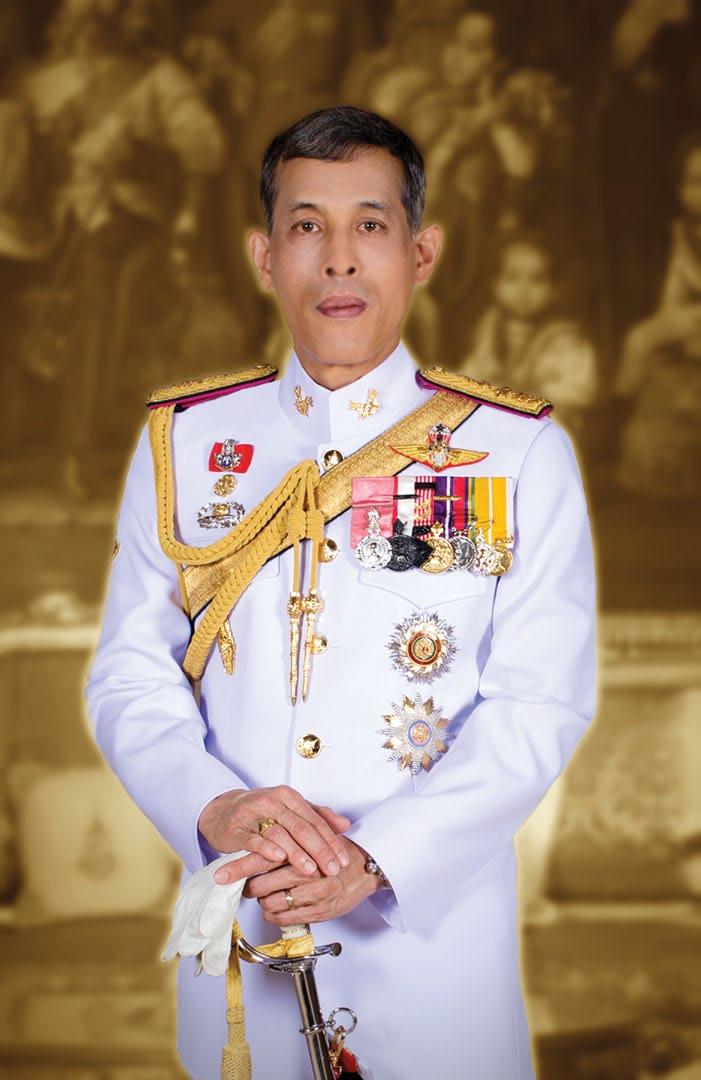






































































Bangkok Airways and Fah Thai magazine wish
His Majesty the King the very best wishes on the Auspicious Occasion of His Birthday Anniversary on July 28, 2025






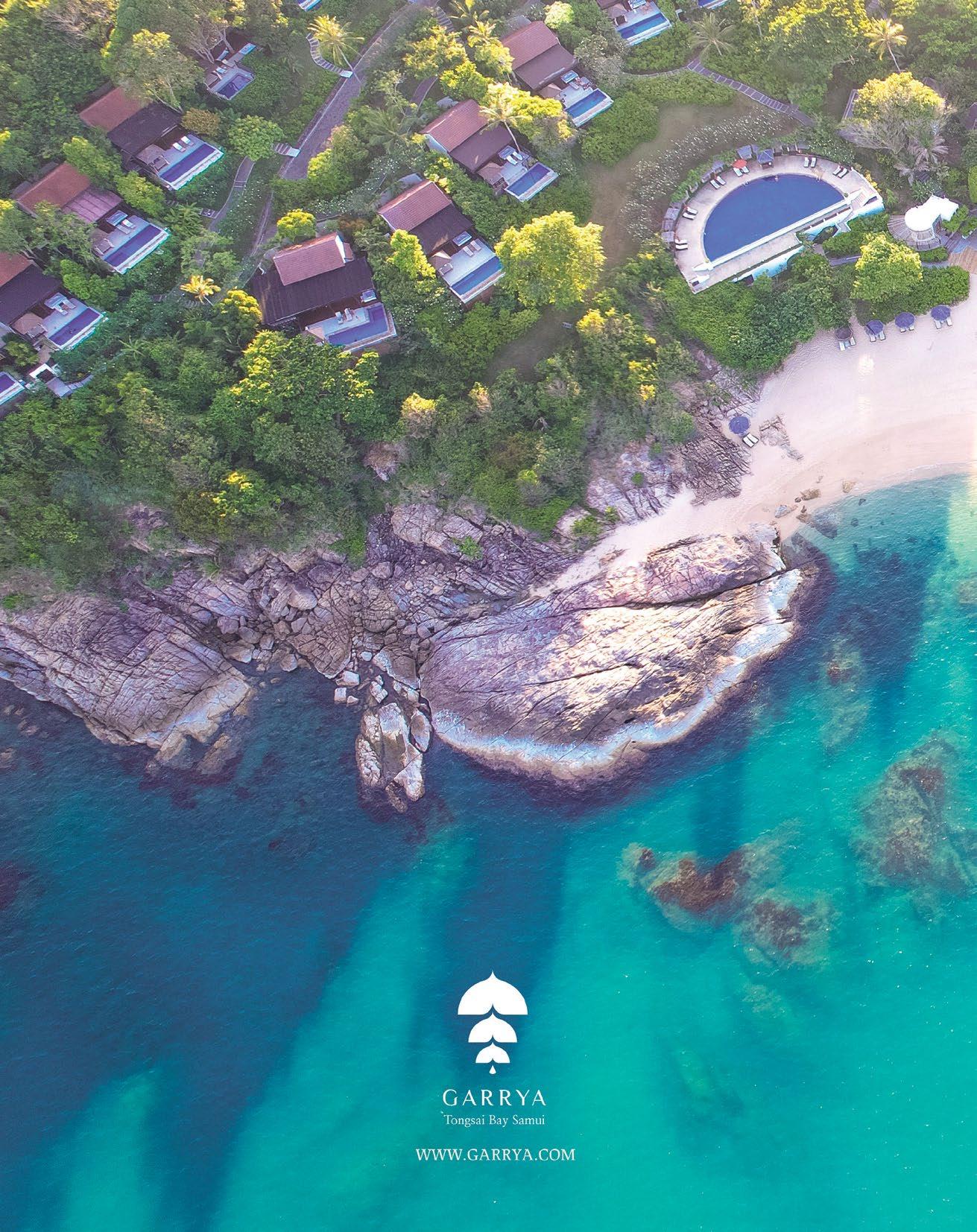
MESSAGE FROM THE PRESIDENT

Captain Puttipong Prasarttong-Osoth
/ President
Bangkok Airways Public Company Limited
Dear Passengers, a very warm welcome aboard Bangkok Airways.
We are deeply honoured that Bangkok Airways has been named the World’s Best Regional Airline and Best Regional Airline in Asia at the SKYTRAX World Airline Awards 2025 for the ninth consecutive year. These prestigious awards reflect our unwavering commitment to excellence and were only made possible by our passengers’ overwhelming trust and support. On behalf of everyone at Bangkok Airways, I am sincerely grateful for each and every vote, as your confidence continues to inspire and drive us forward.
To further enrich your journeys, our new “Trat Discovery: Islands and Beyond” campaign – in partnership with the Tourism Authority of Thailand – offers exclusive privileges for Bangkok Airways’ passengers exploring Eastern Thailand, including the chance to win free flights. Visit Facebook/ Instagram: @TratDiscovery for more details.
We also invite you to join the Bangkok Airways Boutique Series 2025, our annual tourism running events. The series kicked off with the Samui Half Marathon in June and continues with the Trat Half Marathon on August 16-17 and the Sukhothai Half Marathon on September 27-28. Visit Facebook: bangkokair.run for details.
When it comes to food and beverages –served both onboard and in our passenger lounges – Bangkok Airways continues to create delicacies with passenger satisfaction in mind. A new special menu is introduced every month for your enjoyment. Most recently, we unveiled the refreshing “Mayongchid Loy Kaew” – chilled marian plum in syrup – at our Blue Ribbon Club Lounge in Bangkok’s Suvarnabhumi Airport.
This seasonal delight, made with fruit picked from our own organic farm at Sukhothai Airport, is available until the end of October 2025.
Finally, we hope you enjoy a smooth and pleasant journey with us, and we thank you once again for choosing to fly with Bangkok Airways. We remain committed to delivering unmatched service and being your airline of choice for years to come. Thank you.

“Trat Discovery: Islands and Beyond”




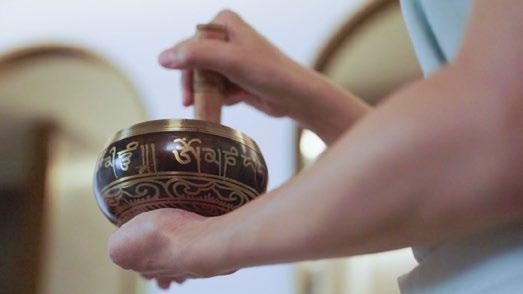


BANGKOK AIRWAYS PUBLIC COMPANY LIMITED
99 Mu 14, Vibhavadi Rangsit Road, Chom Phon, Chatuchak, Bangkok 10900, Thailand www.bangkokair.com
ADVISORY BOARD
Amornrat Kongsawat
Vice President – Sales
Komkrit Ngamwongwirot
Director - Key Account and Ancillary Product
Thanut Na Nakon Chanachon
Manager - Ancillary Product
Tanchanok Aunmueang
Officer - Ancillary Product



PUBLISHER
MPMI Group Co., Ltd.
1 Soi Lasalle 23 Yaek 2, Bangna Tai, Bangna, Bangkok 10260, Thailand
Tel. +66 (0) 2744 4975
Fax. +66 (0) 2744 5271
Managing Director
Steven Fong Chookiat Pangviphas
Email: steven@mpmith.com
EDITORIAL
Email: editorial@fahthaimag.com
Editor-in-Chief Anutra Ungsuprasert
Sub Editor Ramona Varma
Deputy Editor Sarita Urupongsa
Contributors
Jeremie Schatz
Kankanit Wichiantanon
Paphaon Suwannathamma
Pattarawadee Saengmanee
Phoowadon Duangmee
Pinanong Panchuen
Richard Augustin

ART
Creative Director JyeShen Koo
Art Director Pongtorn Khaoplag
PRODUCTION
Printer Cyberprint Group Co., Ltd.
MANAGEMENT
General Manager Daruni Klaprapchon
Account & Administration Manager Supavadee Salyajivin
Digital Marketing Manager Nichapat Noraphaiphipaksa
Media Sales & Services Kornnika Thongmorn
ADVERTISING HOTLINES guitar@mpmith.com kornnika@mpmith.com
Guitar +66 (0) 87 929 6611
AUSTRALIA
THE MEDIA COMPANY
Leanne Richardson Tel: +612 9909 5800 leanne@themediaco.com.au
CAMBODIA, LAOS, MYANMAR
Kittikun Adunsirisaward Tel: +668 9468 2440 kittikun@bangkokair.com
CHINA, HONG KONG, MACAU, TAIWAN
CHINA MEDIA OPTIONS CO., LTD.
Rebecca Tsang-Pereira Tel: +852 3951 0388 rebeccaCMOsupport@gmail.com
FRANCE, GERMANY, SWITZERLAND
INFOPAC MEDIA HOUSE
Jean Charles Abeille. Tel: +331 4643 0066 jcabeille@infopac.fr
INDIA, MALDIVES RMA MEDIA
Faredoon Kuka Tel: +9122 2925 3735 kuka@rmamedia.com
KOREA
MEDIREP CO.
Soohoon Oh Tel: +822 734 0786 soohoonoh@medireponline.com
JAPAN MR. FUSION
Hiroko Minato Tel: +813 5495 7355 minato@mrfusion.co.jp
MALAYSIA
MPMI SDN BHD
Alvin Tan Tel: +603 7880 2185 mpmimy@gmail.com
SINGAPORE, INDONESIA
MPMI PTE LTD
S. S. Hoo Tel: +65 6464 6261 mpmisg@gmail.com
UNITED KINGDOM
MAJOR MEDIA LTD.
David Hammond Tel: +44(0) 20 8467 8884 david@majormedia.co.uk
USA
THE MULTIMEDIA INC.
Fernando Mariano Tel: +14 0790 3500 fmar@multimediausa.com
“FAH THAI” is the in-flight magazine of Bangkok Airways Public Company Limited and is edited and published by MPMI Group Co., Ltd. All articles and photographs published herein are created by the authors and photographers at their own discretion and do not necessarily represent the views of the airline. Bangkok Airways holds no responsibility or liability arising out of the publication of such articles and photographs.
All information correct at press time. All rights reserved. No part of this magazine may be reproduced, stored in a retrieval system or transmitted in any form or by any means without the prior written permission of Bangkok Airways Public Company Limited and MPMI Group Co., Ltd.


From vibrant art expos and sporting events to traditional festivals, Bangkok Airways destinations have plenty of unmissable experiences to offer.
Ocean waste to couture – Thai brand Pipatchara proves that high-fashion can tackle trash and inspire sustainability.
This sweet-and-salty pandan-wrapped treat embodies Thai cuisine’s dance with tastes and textures.
Ancient temples, elephant bonds and vibrant crafts showcase Surin – a province shaped by dynasties, traditions and spirit.
Glide across moonlit Phayao Lake, as candles flicker, chants rise and a beautiful Buddhist ritual unfolds in quiet devotion.

34 SAMUI’S HEART & SOUL
Lifting the lid on the living heritage, customs and hidden stories that make this paradise island so special.
50 ROYAL THREADS
Follow the Thai silk trail laid by Her Majesty The Queen Mother – from humble village weaves to a global success story.
62 REIGN OF RAINS
Explore the tranquil, lush landscapes and soulful adventures of Thailand’s monsoon season.
Check out the newest must-visit spots across Thailand and beyond.
74 SAMUI
76 PHUKET
78 KRABI
79 CHIANG MAI / PATTAYA / TRAT
80 BANGKOK
81 HONG KONG / SINGAPORE
84 PHNOM PENH / SIEM REAP
85 LUANG PRABANG / MALDIVES
88 BANGKOK AIRWAYS NEWS
93 ROUTE MAP
94 KHAO SOK’S WONDERS
Discover Thailand’s oldest rainforest, where mist-covered cliffs, hidden blossoms and jungle secrets await.











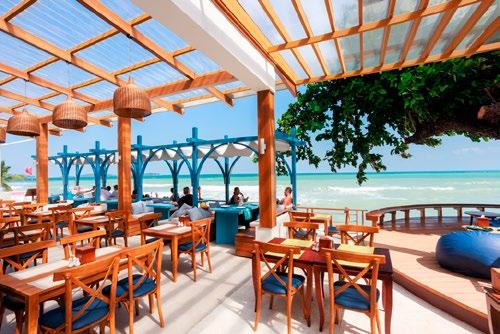







The red palace of Surin’s elephant kingdom rises above Ban Ta Klang, its vast courtyards and towering arches echoing the grandeur of ancient Khmer temples. Within its walls, elephants roam free, embodying the region’s deep bond between humans and nature’s most majestic creatures. Every brick speaks of the Kui people and their centuries-old partnership with these gentle giants.




BANGKOK IDENTITY UNDER THE LENS
Agni Gallery’s group show “Only Faces on My Mind” explores the rich potential of portraiture in the digital age. On view until July 30, the exhibition features works by renowned artists like Adriana Oliver and Lino Lago from Spain, Germany’s Andre Schulze, Belgian-Lebanese visualist Celio Koko and Los Angeles-based Chance Cooper. The portraits go beyond mere representations – think blurred, fragmented or entirely absent faces – to invite reflection on identity, anonymity, and the weight of the human visage. Spanning expressionism to minimalism, the show reveals portraiture as a dynamic, evolving form. Tucked inside Soi Ruamrudee, Agni Gallery is emerging as a vital platform for contemporary art in Bangkok. agnigallery.com





NOW AUG 2025-31
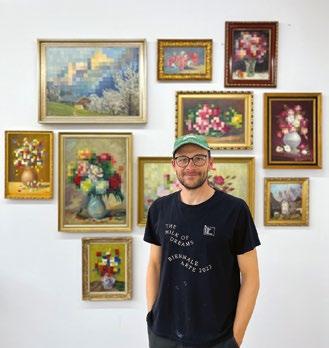
Singapore is celebrating its 60 th birthday with “Mandai is Wild About SG” – a campaign of wild fun across Singapore Zoo, the Night Safari, River Wonders, and Bird Paradise. Until August 31, guests can enjoy traditional snacks, special family promotions and unique animal interactions – think otters with satay props or parrots singing the birthday song. The parks are unveiling new features like Singapore-themed Insta spots, educational trails and limited-edition merchandise, while visitors are invited to share their fondest zoo memories over the decades. Night Safari and River Wonders offer guided experiences that blend local stories with wildlife wonder, while Bird Paradise stages a heritage-themed show under the stars. Whether you’re reliving childhood memories or making new ones, the parks promise playful tributes to six decades of Singaporean pride. www.mandai.com/sg60



Get ready to sprint, jog, or stroll through the scenic streets of the Maldives’ island city during the Hulhumalé Run 2025. Held by Elite Runners Maldives, this annual event features multiple race categories – from a children’s 1-mile run to 5km and 10km routes for adults – making it perfect for all ages and fitness levels. Trophies will be awarded to the top three finishers in all age groups. The event boosts community spirit, youth empowerment and good health, with proceeds supporting budding local athletes. Expect to enjoy scenic island views blending turquoise seas with lush green landscape, as you are cheered on by an exuberant crowd. The race starts at Hulhumalé Central Park and offers participants a dynamic way to connect with the local community and surroundings. Register at www.hulhumalerun.mv



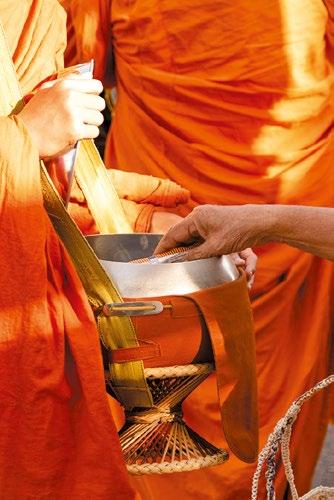
10 -11JUL 2025
ACROSS THE REGION DAYS OF DEVOTION
Two of Buddhism’s most sacred days – Asalha Bucha marking Buddha’s first sermon and Khao Phansa, the start of Buddhist Lent – fall on July 10 and 11, respectively, this year. To mark the occasion, temples across Thailand and neighbours like Laos and Cambodia will be filled with quiet devotion as worshippers gather to give alms, join candlelight processions, and offer candles, incense and lotus flowers. Travellers can witness these timeless traditions at Bangkok Airways destinations such as Chiang Mai, Sukhothai, Lampang and Trat. Whether you spend them in bustling Bangkok or the quiet countryside, these two days offer close encounters with the living heritage of Theravada Buddhism. www.tourismthailand.org


18 -20 JUL 2025
The Pai Jazz & Blues Festival arrives in July, transforming the mountain town’s cafés, bars and boutique resorts into intimate live venues. The eighth edition of northern Thailand’s coolest music festival features local favourites like Banglumpoo Blues Company, Chiangmai BLUES featuring Ming, Brown Sugar Band, Aek Wild Sax Band, Mojo Band and more, with sets spanning jazz standards to down-home blues. The mountain backdrop and laid-back vibe make it feel more like a community jam than a commercial festival. Venues include The Blue Ox, Re-Connect: Nature Lodge Pai, and the stylish Silhouette by Reverie Siam. With great food, cool air, and warm grooves, this is one of Thailand’s most atmospheric music weekends. Facebook: Pai Jazz & Blues Festival
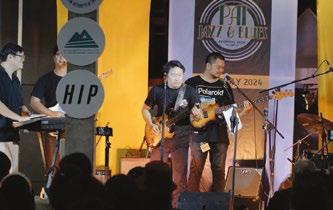

23 -24 AUG 2025
The iconic Summer Sonic music festival returns to Thailand with two days of electrifying performances at IMPACT Challenger Halls, Bangkok. The Bangkok leg brings together a star-studded lineup led by the powerhouse vocals of Alicia Keys, performing hits from her 17 Grammy-winning career, Black Eyed Peas, Camila Cabello, and K-pop sensation CHANYEOL, stepping out solo from EXO. Adding a local buzz are Thai artists like Jeff Satur and Lamyai Haithongkham. Fans can expect themed food zones, artist merchandise, and interactive fan booths. Known for its sleek production and high-energy performances, Summer Sonic Bangkok delivers the best of Asia’s contemporary music scene under one roof – creating a thrilling weekend for festivalgoers and first-timers alike. www.summersonicbkk.com





Thai fashion house Pipatchara transforms deadly ocean waste into world-class fashion, redefining style through sustainability
Standing at the crossroads of couture and environmental activism, Bangkokbased fashion house Pipatchara is weaving marine waste into high-end design. Founded by sisters Pipatchara “Petch” Kaeojinda, a fashion designer, and Jittrinee “Tuptim” Kaeojinda, a sustainability specialist, the brand is not only transforming wardrobes – it is challenging the very notion of what fashion should be, and why it matters.
Already a fixture on the global fashion circuit – showcasing in Paris, New York, Dubai and London –Pipatchara grabbed the spotlight when BLACKPINK’s Lisa (Lalisa Manobal) appeared at the 2024 Formula 1 Monaco Grand Prix in a bespoke shimmering two-piece. The stunning outfit, crafted from over 1,800 pieces of recycled plastic – 80% from used bottle caps and 20% from food containers – embodied the label’s cutting-edge vision and ecological conscience.
But behind the couture glamour lies a serious mission – one that goes far beyond token eco totes.

The brand’s sustainability journey began with its Infinitude collection, which transformed discarded plastic caps into sculptural geometric fashion. Far more than a mere line of clothing, it was a manifesto – sewn with intention and community spirit.
Now, the label is venturing further offshore. With Aqua R Us, Pipatchara turns its focus on the ocean’s most insidious pollutant: discarded fishing nets. Deadly to marine life and notoriously slow to degrade, these “ghost nets” are reborn as luxury fashion items – part of a growing movement to reclaim waste and lend it lasting value.


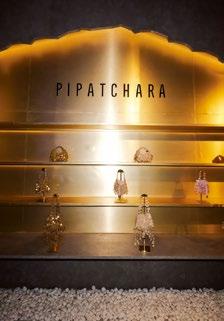
Launching on July 4 at Underwater World, Siam Paragon, the Aqua R Us collection will debut 40 new looks, including garments, handbags, shoes, hair clips and other accessories. Every piece incorporates up to 80% recycled fishing nets, offering a striking vision of sustainable design’s exquisite potential.
“Also, we have curated an exhibition that tells the story of how old fishing gear is transformed into fashion items –explaining why we chose to combine discarded nets with high-end fashion,” says Pipatchara, whose résumé includes stints with global brands like Ralph Lauren, Vanessa Bruno and Givenchy.






Made primarily from nylon, fishing nets can take up to 600 years to degrade. Their environmental toll is immense – from entangling sea turtles and dolphins to shedding microplastics that contaminate the food chain.
Recognising this, Pipatchara partnered with UBE, a major nylon manufacturer, and Bangkok Airways to create a system for retrieving and recycling these materials.
“It’s not just about using recycled materials,” adds Pipatchara. “It’s about long-term commitment to the communities we work with.”
For the past three years, Pipatchara has collaborated with communities in Northern Thailand to foster sustainable livelihoods, strengthening these efforts through Aqua R Us. Fishing villages along the Gulf of Thailand help by collecting and sorting nets. Designers and researchers engage directly with locals, learning the nuances of materials and lifecycles.
With Bangkok Airways’ help, the team visited remote coastal areas to witness firsthand how quickly nets become waste – often discarded after just four or five months of use.
What followed was innovation on every front.

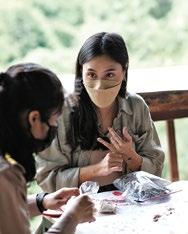
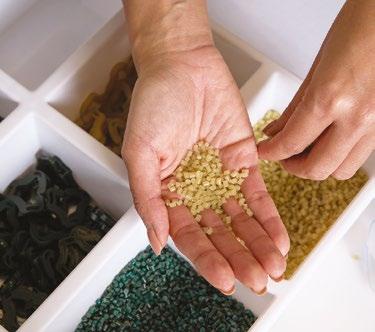

One major hurdle? Colour. Recycled nylon, in its raw form, yields only black – a constraint for any designer – let alone a fashion designer. Rather than dilute the material with virgin plastic, Pipatchara worked with UBE scientists for nearly two years to develop a fully recycled, colour-friendly nylon. The result: a palette of rich hues with broad application potential – from fashion and furniture to automotive parts.
Though recycled nets are no longer good for fishing due to degradation, they remain a valuable plastic. Pipatchara is teaching local communities how to craft design items from the material, aiming for a truly circular system – local nets, local labour, global visibility.
“This is very high-quality plastic,” says Pipatchara. “It just needs the right application.”
The goal of Aqua R Us is not just to dazzle on the runway – it’s to spark conversation. Sculptural handbags, architectural silhouettes, and modern accessories showcase the power of creative reuse. Each piece defies expectation: you’d never guess its origins lie in the ocean.
“The final product doesn’t look like a fishing net at all,” she adds. That’s the pride of Pipatchara – turning something harmful into something desirable.
With Aqua R Us, Pipatchara delivers a powerful message: fashion must be part of the solution. By refusing
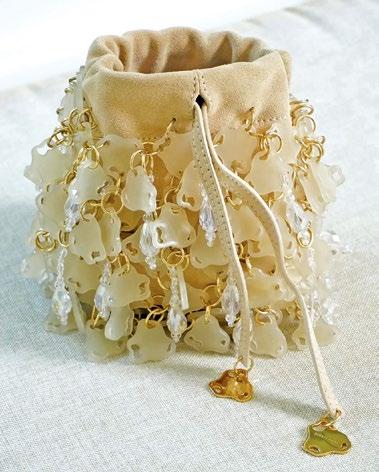
• Discarded fishing nets are made from nylon plastic, which can take up to 600 years to degrade.
• These “ghost nets” often trap and kill turtles, dolphins, fish and other marine animals.
• Coastal economies suffer when these nets litter tourism beaches or harm coral reefs.
• Recycling fishing nets into usable products diverts waste away from oceans and empowers local communities.
shortcuts and focusing solely on 100% recycled materials, the label redefines what it means to be truly sustainable.
“This isn’t just about fashion,” says Pipatchara. “It’s about showing other industries what’s possible. If more people start using this kind of recycled material, we can change the whole system.”
Indeed, Aqua R Us is more than a collection – it’s a movement. A call to action. A stitchby-stitch demonstration of how creativity and design can drive change when rooted in care, community, and courage.


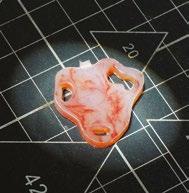
Cay Restaurant, located in Anantara Lawana Koh Samui Resort, elevates Thai cuisine to new levels with an unmatched commitment to tradition and finesse. The exquisite menu invites diners on a journey through all four regions of Thailand, striking a balance between time-honoured flavours and cutting-edge culinary expression.
Boat-fresh seafood from Hua Thanon stars in dishes like Gaeng Poo – a rich southern crab curry featuring finger ginger, homegrown betel leaves and acacia. Grilled Pla Yang and Goong Yang are finished with silky Panang curry and a hint of kaffir lime for depth and aroma. Other highlights include Scallops Phad Cha, stir-fried with Cay’s house-made chilli paste and holy basil, and Koi Goong, a bright and zesty ceviche prawn salad from the Northeast.
Sustainability is at the heart of Cay’s kitchen. Think rice ethically sourced from farmer-run mills
in the Northeast, coconut milk hand-pressed each morning, and curry pastes crafted in-house. Fish bones and prawn shells are expertly transformed into flavourful broths and mouthwatering savoury chips.
Fruits of Samui’s terroir shine in the Ped Klong Phai Farm dish: honey-glazed free-range duck with sweet peas, tamarind sauce and roasted rice powder. Meanwhile, the Pork Belly Stew – slow-braised with soy, sugarcane, cinnamon and star anise – delivers soul-deep comfort.
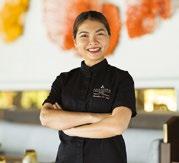



The culinary journey begins with a rotating amuse-bouche, paired with insights from Cay’s passionate team. More than just a restaurant, Cay is an homage to Thai culinary heritage – rooted in warmth, sustainability, and bold, unforgettable flavours.



CAY Restaurant
Address: 92/1 Moo 2, Bophut, Koh Samui, Surat Thani
Tel: +66 (0) 7796 0333
Email: fbs.als@anantara.com
Suspended high among the trees, Anantara Lawana’s Tree Tops

Signature Dining delivers a unique blend of intimacy, elegance and immersion in nature – with flavours to match. With just eight private pavilions (salas) nestled high in the lush canopy, this secluded perch is among the island’s most coveted dining experiences – serene, romantic and oh so personal.
Helming the kitchen is Executive Chef João Costa, a Portuguese talent whose culinary

odyssey spans top restaurants from Europe to the Maldives. His philosophy is rooted in refinement and restraint, with a strong emphasis on seasonality and provenance. Around 80% of ingredients are sourced from across Thailand, shaping a menu –relaunched in February 2025 – that is both contemporary and deeply respectful of the land. Anticipate delicately layered textures, graceful flavour progressions and quiet confidence in every plate.


Elevating the journey is sommelier
Emma Rangsinee Promjant, whose pairings transform each course into a narrative, matching Chef Costa’s compositions with precision to resonate on every sensory note.
Tree Tops is also a model of sustainability, both in sourcing and its ethos of mindful, ecologynurturing luxury. More than a meal, this is a high-altitude celebration of craft, connection and culinary finesse – where every detail feels quietly transcendent.
Tako should come with a warning: this beloved Thai dessert’s enticing looks and unique taste can be instantly addictive for foodies. Wrapped in fragrant pandan cups, these small coconut puddings are famed for their delicate sweet-salty flavour and delightfully chewy texture.
The best part is they are surprisingly easy to make. Tako is a marriage of two perfect partners – a soft, chewy base made from flour and sugar, topped by a rich coconut fondant.
For the luscious topping, mix coconut cream, rice flour and tapioca starch in a pot and whisk until smooth. Add sugar, a pinch of salt and a touch of pandan for the
signature Tako taste. Stir the mixture over a medium heat until it thickens to a velvety consistency, then set it aside to cool.
For the base, boil sago pearls until they become translucent with tiny white centres. Add jasmine water, sugar and salt, and stir until perfectly blended. Toss in your fillings of choice – steamed taro or sweetcorn kernels are classic picks – and mix until everything is evenly coated while ensuring that the mixture doesn’t stick at the bottom of the pot. Remove from the stove.
If you don’t have sago, don’t worry. You can make a simpler version of Tako by boiling rice flour, taro, pandan
Thailand’s two-layered coconut pudding packs an irresistible flavour profile
leaves, sugar and salt in jasmine water until you have a smooth pudding. Now comes the fun part –assembling your dessert. Grab your pandan leaf cups and fill them twothirds full with the base mixture, then spoon the velvety coconut topping over the top. For flavoured Tako, you can add a pretty garnish that hints at the filling inside. Let the cups cool down and set for a few minutes before serving them slightly warm. They can also be refrigerated to save as a cool, refreshing snack later.
In Thai dessert shops, look out for popular flavours like chestnut, corn, taro, young coconut, longan, and sweet potato.
Flower Power
Jasmine water may sound fancy, but it’s delightfully easy to prepare – and adds a tempting fragrance to desserts. Simply boil water, let it cool to room temperature, and then sprinkle in freshly picked and washed jasmine flowers. Cover the container and leave it overnight to allow the blossoms to infuse their fragrance. By morning, you’ll have a delicately scented water that smells like a moonlit garden. For the best results, pick the jasmine flowers at night – when their scent is at its peak.


is the perfect souvenir !
Made with the finest Thai cacao beans and local ingredients, Siamaya Chocolate makes shareable memories of Thailand!
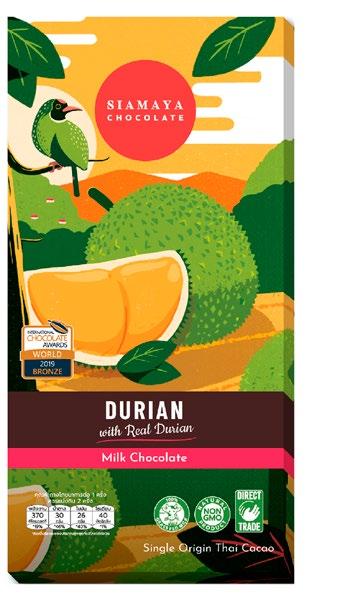


Available throughout Thailand, including these fine locations:
Siamaya Stores Rimping Supermarket Tops Food Hall www.siamayachocolate.com

Hop aboard for a ride through the Khmer Empire, still whispering its stories in this quiet corner of northeast Thailand


At first light, Surin seems to emerge from the mist, magically reborn. In this quiet corner of Thailand’s Northeast, mahouts and young children sway through rice paddies on the backs of elephants, their outlines blurred by dawn’s soft glow. Ancient temples scattered around the province tell stories of forgotten gods in stones worn smooth by centuries of monsoon rain and summer heat. Across sunlit villages, the clack of wooden looms rings out as nimble fingers weave goldthreaded silk – just as their ancestors did long ago.
Usually bypassed by tourists drawn by Thailand’s famous beaches and royal cities, Surin boasts some of the nation’s deepest roots – preserved in sacred stones, gentle rivers, traditional crafts, and a deep connection with the land.
The province’s own roots stretch back more than 2,000 years. Once part of the ancient Khmer Empire, its history is interwoven with the grandeur of Angkor.
Ruined temples and palaces still dot the countryside, the last remnants of oncepowerful city-states.
When the Khmer kingdom faded into history, the land grew silent – until the Kui (Suai) people arrived in the 18th century. Renowned for their extraordinary bond with elephants, they crossed the Mekong to settle here, earning royal favour by capturing a prized white elephant for the Ayutthaya court. In 1763, their leader Luang Surin Phakdi decided to move his town to a more prosperous and defendable location. In recognition of his service and loyalty, Ayutthaya’s king named the new town after him: Surin. Today, elephants still set the rhythm of life in Surin, as surely as the monsoon rains shape the rice fields.
At the heart of Surin stands the City Pillar Shrine, a guardian of the city’s spirit. This three-metre-tall totem, carved from
Top A woman and an elephant stroll through a paddy field – a quiet moment that reflects Surin’s enduring humanelephant bond
Chaiyaphruek wood, embodies the city’s beating heart and is the best place to start your journey of discovery. A few steps away, the bronze statue of Phraya Surin Phakdi Si Narong Changwang keeps watch over his territory with a sword slung across his back and elephant goad in hand.
For your first stop, we recommend Wat Burapharam, home of the revered Luang Pho Phra Chi, an ancient Buddha image crafted in the Khmer style. Here, monks once received oaths of allegiance to the city’s founder, and to this day, locals seek blessings and protection here.
Just to the south, at Wat Pa Achiang, the profound bond between humans and elephants is honoured in a solemn display. In its Elephant Graveyard, over 200 of these majestic beings rest beneath sculpted palm-leaf tombstones – a tribute to their status as kin, not merely creatures.
For an eagle’s-eye view of Surin, Phanom Sawai Forest Park offers treks to three sacred peaks: Phanom Phrao



(Khao Chai), crowned by a towering white Buddha, Phanom Sarai (Khao Ying), with ancient ponds of sacred turtles, and Phanom Kron, home to a replica Buddha’s footprint. From these summits, Surin’s gentle landscape unfolds like a prayer.
Scattered across Surin are ancient stone relics of its Khmer heritage – a world of gods, warriors, and healers.
At Prasat Sikhoraphum, delicate carvings of Shiva, Vishnu, and dancing apsaras stare from weathered brick towers. Built as a Hindu temple and later converted for Buddhist worship, it reflects the centuries-long flow of religious currents through Southeast Asia.
Hidden deeper in the countryside, Prasat Phum Pon and the Ta Muen temple complex reveal the evolution of Khmer architecture – sanctuaries that became healing centres under King Jayavarman VII. At Prasat Hin Ban Phluang, a quiet yet

Clockwise from Top Left
An elderly artisan displays silkworm cocoons – the first step in Surin’s intricate silkweaving tradition
The brick observation tower at the Elephant Kingdom in Ban Ta Klang
Intricate Thai patterns and celestial motifs adorn the interior of Surin’s sacred City Pillar Shrine
Carvings of deities and dancers grace the towers of Prasat Sikhoraphum, echoing Surin’s Khmer past
intricate sanctuary, bas-reliefs of Krishna and Indra are framed by curling lotus garlands and elephants, connecting celestial myths with the earthbound creatures that still roam the area today.
However, Surin’s heritage is not confined to ruins; it still flourishes in the hands of artisans. In Ban Tha Sawang village, weavers crouch in earthen pits, manipulating hundreds of loom strings to create shimmering gold brocade once reserved for royal courts. Here, each inch of fabric takes days to weave – a meditation on patience and beauty.
Nearby in Ban Sawai and Ban Pho Kong, traditional silk weaving incorporates age-old motifs drawn from the landscape: the bold elephant and the delicate eggplant flower. Visitors are invited to dye silk, harvest organic vegetables, and share meals featuring river fish flavoured with local herbs.
In Khwao Sinarin village, the taptap-tap of silver hammers echoes across
courtyards. Craftspeople shape Luk Prakuem – silver beads embossed with lotus and flame patterns – into necklaces and belts that marry ancient designs with modern elegance.
In Ban Ta Klang, elephants are not just a spectacle – they are family. For centuries, the Kui people ventured into Cambodia’s forests to capture and train wild elephants, a tradition born of necessity and reverence. Today, the relationship has shifted towards conservation and dignity.
At Elephant World, visitors can watch these gentle giants paint, dance, and engage in playful games – skills learned through trust, not violence. More profoundly, the Elephant Kingdom Initiative, inspired by Her Majesty Queen Sirikit The Queen Mother, provides a vast sanctuary where over 170 elephants live free from exploitation, offering a model of ethical stewardship.
Everyday stories of mahouts sleeping beside their elephants, and elders recalling the great elephant roundups, reveal Surin’s enduring, adaptable, deeply tender spirit.
Surin’s countryside also sways to the quiet rhythm of seasons. At Satom Organic Farm, tucked along the Chi River, rice cultivation is more than a livelihood – it’s a ceremony. Visitors can learn to plant, harvest and make sato rice wine – joining a cycle that binds earth, water and community.
As the Huai Saneng Reservoir turns gold under the rising sun, locals jog, cycle, or simply breathe in the morning mist –a reminder that nature is both sanctuary and sustenance in Surin.
To understand Surin fully, you have to visit its National Museum. Here, lintels salvaged from Khmer ruins, finely spun silks, and silver heirlooms come together to chart the province’s journey –through nature, empire, colonisation, and community life. The elephant villages and marketplaces recreated within its walls remind visitors that Surin’s heritage is not dusty history – it is lived, celebrated, and protected even today.
Top to Bottom
Nam Phrik Jarua Dong – a creamy, coconut-based chilli dip unique to Surin – delivers intense flavour rooted in Khmer tradition
Silken threads stretch across a loom in mid-weave – a testament to Surin’s timehonoured practices
Silverwork takes shape by firelight as a local artisan brings age-old patterns to life



Surin’s strength also lies in its diversity. Kui mahouts, Khmer artisans, Lao farmers, and Thai-Khorat merchants have blended their cultures for generations, shaping a province of intertwining traditions. Performances of Reamker (the Khmer Ramayana), vibrant Kantrum folk music, and communal rituals reflect a harmony born not of uniformity, but of a shared and richly layered history.
Surin’s identity is also savoured in its culinary favourites – river fish under layers of herbs, and fragrant jasmine rice steamed in banana leaves.
The local jasmine rice, prized for its soft texture and floral aroma, is more than a staple – it’s a symbol of local pride and deep tradition. Grown in rain-fed paddies using age-old methods, it captures the spirit of the land.

Surin lies in the heart of the Isaan region, famed for its Thai culinary gems like Som Tam (Spicy Papaya Salad) and Laab (Minced Meat Salad). But among its unsung treasures is Nam Phrik Jarua Dong – a creamy, coconutbased chilli dip, rooted in Khmer cooking tradition. This intensely savoury relish is best enjoyed with crisp vegetables and steamed jasmine rice – even global icon Lisa of BLACKPINK is a fan.
Visitors to Surin step into a living memory, where carved lintels tell of empires past, silk threads shimmer with ancestral pride, and elephant trails etch devotion into the soil. Listen closely and you can hear this land speak – through the gentle rumble of elephant steps, the whisper of wind through rice paddies, and the rhythmic clatter of looms at work.
IN SURIN, EVERY DAY IS ELEPHANT DAY
August 12 may be World Elephant Day – a global call to protect and cherish these gentle giants – but in Surin, that call has echoed for centuries. Here, among the paddy fields and forest-fringed villages, ties between humans and elephants run deep. For the Kui people, who settled here centuries ago, elephants are neither performers nor pets – they’re family.
In Ban Ta Klang and beyond, this ancient bond has shaped a new model of care. Inspired by Her Majesty Queen Sirikit The Queen Mother, projects like Elephant World and the Elephant Kingdom Initiative provide humane, natural sanctuaries where elephants can roam freely and live well. Far from the spectacle of street parades, these initiatives are a quiet revolution in conservation – where tradition meets ethical progress.
However, if you are lucky enough to visit Surin on World Elephant Day, be ready to sway along in a vast celebration of its beloved giants.

Just a short drive from the vibrant shores of Pattaya, an extraordinary escape awaits: Columbia Pictures Aquaverse, the world’s first fully integrated movie-themed water park and theme park. Developed in collaboration with Sony Pictures Entertainment, the park transforms beloved cinematic universes into vivid, immersive experiences – all under Thailand’s tropical sun.
Crowned the “Best Theme Water Park 2023” by the MAFTA Awards and featured in both CNN Travel’s Top 8 New Theme Parks (2023) and Trip.com’s Trip. Best Global 100 (2024), Columbia Pictures Aquaverse is redefining entertainment in Southeast Asia. Far more than a thrillseeker’s paradise, Aquaverse offers a multi-sensory journey through films like Jumanji, Ghostbusters, Hotel Transylvania, and Gran Turismo. Whether you’re dodging jungle hazards, racing through high-octane circuits, or floating beneath the stars in a poolside cinema, the park invites you to live the movies in ways that feel both fantastical and real.
Aquaverse isn’t just for adrenaline-seekers – it’s for everyone. While heart-pounding water slides and racing go-karts entertain the bold, wellness havens like the newly launched Onsen Zone provide a soothing counterbalance. Guests can soak in mineral-rich hot springs or cool down

in plunge pools – an indulgent pause between high-energy adventures.
Families with young children will love the playful charm of the Hotel Transylvania zone, while teens and gamers will gravitate to Gran Turismo’s speed circuit and virtual thrills. And with the surf simulator, the only one of its kind in Eastern Thailand, everyone can test their balance and bag an Instagram-worthy shot.
The park also boasts a full calendar of live performances – from character shows to cultural showcases – making each visit unique. Dining also transcends theme park fare, with everything from global comfort food to creative snacks inspired by film characters. Think Slimer-green slushies or Transylvania-themed bento boxes.
For those craving a deeper dive, Aquaverse offers short workshops ranging from dance and culinary classes to underwater explorations. These

hands-on experiences turn the park into more than just a leisure paradise, creating a cultural touchpoint where fun meets discovery.
With spacious grounds and professional facilities, Aquaverse is also emerging as a unique venue for corporate retreats and incentive travel. Its Megawave Pool, by day a wave ride and by night an open-air cinema or concert venue, is particularly popular for private events – offering a versatile backdrop that’s both functional and memorable.
888 Moo 8, Na Jomtien, Chon Buri, Thailand 20250
Line: @Aquaverse
Tel: +66 (0) 3300 4999
Facebook: Columbia Pictures Aquaverse
Instagram: Columbia Pictures Aquaverse www.columbiapicturesaquaverse.com



Where Movie Magic Meets Fun – Start Your Journey Today If you’ve ever dreamed of diving into your favourite movies, now’s your chance.
Columbia Pictures Aquaverse isn’t just a theme park – it’s a cinematic adventure of a lifetime.
Getting There
Just 90 minutes by car from Bangkok or 25 minutes from South Pattaya, with convenient transfers also available from U-Tapao Airport.
Park Hours
Open daily from 10am to 6pm, except Wednesdays.
Book Now www.



Looking for a travel experience that weaves together history, spirituality, and breathtaking scenery? Head to northern Thailand, where thrice a year the tranquil waters of Phayao come alive with candlelight, chanting, and a unique cultural spectacle.
While cities like Chiang Mai and Chiang Rai dominate the northern tourist trail, Phayao remains a well-kept secret – its quiet lakeside streets brimming with authentic charm and the relaxed rhythms of traditional life.
However, three times a year, this town nestled among misty mountains is transformed by the luminous beauty of an iconic ritual: the Candlelight Procession on Water.
Imagine gliding across a serene lake beneath a canopy of stars, your candlelight flickering on the water’s surface amid a silence broken only by the gentle splashing of oars. This is Wian Thian Klang Nam – Candlelight Procession on Water – a unique Buddhist tradition found only in Phayao. First held in 2008, this enchanting floating ceremony is now a cherished annual rite celebrating its 17th anniversary this year.


Phayao’s Candlelight Procession on Water brings a sunken Lanna temple to life, illuminating centuries of faith and tradition
Words Sarita Urupongsa
Phayao’s Candlelight Procession attracts visitors not only for its breathtaking visual beauty but also for the spiritual calm it brings to both participants and spectators. Candle-lit boats glide slowly around the lake in a graceful ritual that invites reflection. Many describe it as a spiritual pause – a time to reconnect with their inner lives as the glowing scene unfolds. For those used to the rush of
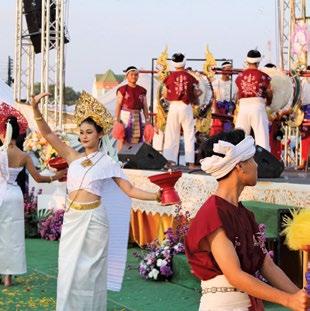
Top
The Candlelight Procession on Water illuminates the lake and lights up the night skies in Phayao
Bottom
Various traditional dance performances captivate visitors
modern life, the ceremony offers a rare tranquillity born not just of silence, but also a shared spiritual intention.
Light and water carry profound symbolic meanings in Buddhism.
The light from candles or lanterns held by worshippers represents wisdom, enlightenment, and the dispelling of ignorance. Water symbolises purity, clarity, and the ever-changing flow of life.



When these two elements are mingled, the Candlelight Procession becomes a richly layered expression of spiritual aspiration.
In traditional candlelight processions held across Thailand, participants walk three times around the temple to honour the “Triple Gem” – the Buddha (the teacher), the Dhamma (the teachings), and the Sangha (the monkhood). In doing so, the ritual becomes a conscious vow to uphold these values in their lives. This meditative experience can be deeply moving, especially for visitors unaccustomed to seeing devotion expressed in such a visually poetic way.
In Phayao, the candlelight procession isn’t held on foot but aboard boats that circle Wat Tilok Aram, an ancient temple

From Top Left Monks gather for the chanting ceremony beneath an illuminated Buddha statue
The serene Phayao Lake
Views of the illuminated Wat Tilok Aram
submerged in the middle of Kwan Phayao (Lake Phayao). This sacred landmark boasts a long and prestigious history, dating back six centuries to the reign of King Tilokkarat in the Lanna Kingdom when it was established on dry land by royal decree.
The temple and surrounding rice paddies were submerged when the Ing River was dammed in the 1930s, creating a reservoir that is now the largest freshwater lake in northern Thailand. In 1983, local fishermen netted relics and ancient artefacts from the lake around the temple, including a much-revered sandstone Buddha image known as Luang Pho Sila. The statue was temporarily relocated to Sri Umong Kham Temple before being returned to its original site in

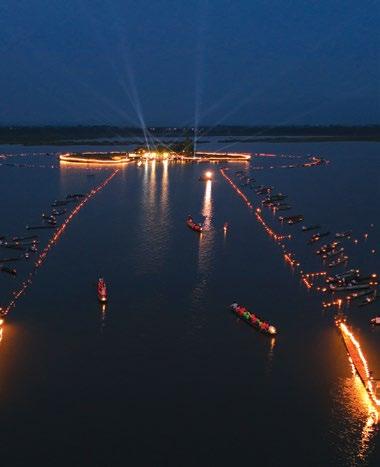
2007, turning the submerged temple into a new pilgrimage landmark.
Phayao’s candlelight procession is held on three sacred occasions each year – Makha Bucha Day in February, Visakha Bucha Day in May, and Asalha Bucha Day in July. The thrice-yearly ritual begins at dawn with devotees offering alms to monks and culminates under moonlight with the magical procession across the lake. The boats paddle around the temple three times before worshippers disembark to pray at the foot of Luang Pho Sila. More than 70 vessels join the procession, turning the lake into a shimmering

Top
A
spectacle of candlelight and devotion, while a strong focus on safety encourages both locals and visitors to climb aboard.
Along with its spiritual side, the floating festival provides a joyful showcase of northern Thai culture, with traditional Lanna performances, live music and dance theatre. Foodies can also browse endless stalls lining the lake, piled high with local and regional delicacies.
Beyond its surface splendour, the Candlelight Procession on Water stands as a powerful expression of Phayao’s deep ties with its ancient spiritual roots. It reveals how faith can adapt, endure and even flourish amid changing landscapes. From a submerged temple uncovered by chance to a region-wide celebration of devotion, Phayao’s unique waterborne rite is a testament to the resilience of tradition and the pull of the spiritual.
For locals, this festival is more than a visual spectacle – it is a living tradition through which sacred values are passed on to the younger generation, ancestral ties are honoured, and memories of the Lanna Kingdom are kept alive. Each year, community leaders, monks, artists and families come together to prepare, participate in and preserve the essence of this precious ritual.
For visitors seeking a truly unforgettable cultural experience, Phayao’s Candlelight Procession on Water offers a unique journey into the heart of Thai history and spirituality.
LOCATION: Tilok Aram Temple, Wiang, Mueang district, Phayao
GETTING THERE: Boats are available year-round from 7.30am to 5pm at Kwan Phayao Pier, for the 15-minute ride to the submerged temple.

WHERE LANNA CULTURE LIVES ON Phayao Lake (Kwan Phayao) was formed when the Ing River was dammed in the 1930s, submerging vast swamplands and reshaping the landscape. Lanna people have lived along these riverbanks for centuries, their traditions and livelihoods fed by the life-giving water. Today, these communities still thrive in the 1,900-hectare river basin known as the Kwan Phayao area.

Tucked away in the heart of Chiang Mai, Hummus Chiang Mai has been serving up fresh, flavourful Middle Eastern cuisine with a modern touch since 2019. This vibrant spot has become a favourite among expats, tourists, and locals alike — drawn in by its relaxed vibe, open kitchen, and honest food.
Step inside to cool, air-conditioned comfort or enjoy outdoor seating with a breeze. Families love our dedicated playroom for kids, while foodies and friends come together over bold dishes that mix tradition with local flair.
From our signature Chiang Mai Hummus to crispy Falafel, our famous Iron Salad, and the irresistible Cauliflower Pita Sandwich, everything is made with care — and served with a smile. Prices range from 120 to 270 THB, making it easy to eat well, whether you’re stopping by for lunch, dinner, or something in between.
“We just love feeding people — real food, made fresh, no shortcuts. Our kitchen is open because we have nothing to hide, and everything to share.” – Amir Peer, Owner and Founder of Hummus Chiang Mai.
Whether you’re in town for a few days or here to stay, come find out why Hummus Chiang Mai is more than just a meal — it’s a place to feel at home.

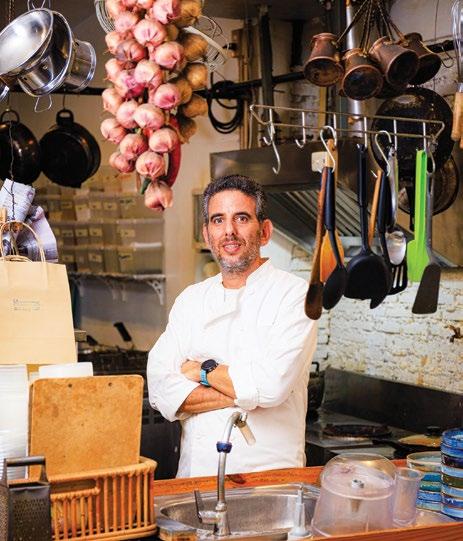
Hummus Chiang Mai
Open daily 8am - 10.30pm
109/1 Mun Mueang Rd, Sri Phum Subdistrict, Mueang
Chiang Mai District, Chiang Mai 50200
Tel: +66 (0) 99 298 5222 www.HummusCM.com

Words Paphaon Suwannathamma
A journey into the heart of Koh Samui uncovers the living heritage and cultural richness of this Thai paradise

Beyond the postcard image of golden beaches and stunning sunsets, Koh Samui pulses with a deeper rhythm – a gentle heartbeat of memories, myths, and the rustle of coconut palms in the sea breeze. For those who linger and listen, the island begins to reveal itself not simply as a holiday destination, but as a centuriesold living story still being written.
The roots of Samui run far deeper than most visitors realise. Archaeological sites in the southern hills have yielded bronze ritual drums etched with birds, boats, and spirit figures – a legacy of Samui’s place on the ancient maritime Silk Road. Long before hotels or guidebooks, Samui had already opened its welcoming arms to passing merchants, sailors, monks and soldiers.


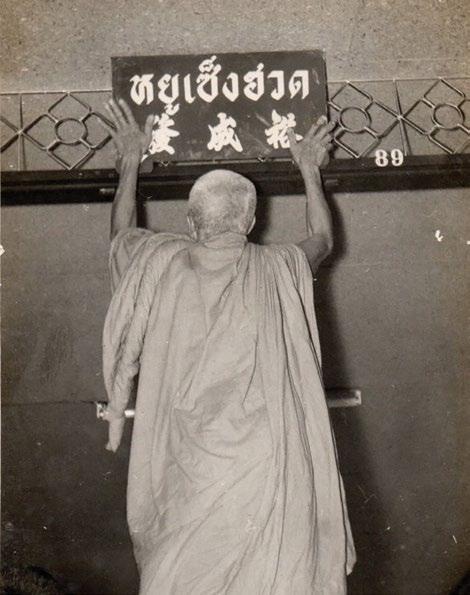
Above
Joo Seng Huad, once Ko Tow’s first family-run restaurant and wedding venue, steeped in ThaiChinese heritage. It later transformed into a transistor repair shop (Below Left)
From Top to Bottom Right
A glimpse into the simple rhythms of old Samui life
Coconut farming was the island’s main livelihood
Monkeys, old companions of the islanders, reflect the deep bond between people and their environment
Born in 1944, Sawai Jarujittipun –fondly known as Ko Tow – is a third-generation Samui local whose family emigrated from Hainan, China. Among the island’s merchant pioneers, they helped shape Na Thon, building the port town’s first concrete structure. Ko Tow recalls the wonder of childhood, watching Imperial Airways seaplanes land at Na Thon: “It felt like the whole world had arrived at our shore.”
His family’s business legacy began with Joo Seng Huad, a ThaiChinese restaurant and wedding venue that later became a transistor repair shop and, eventually,


Chaokoh Hotel Supplies, now a trusted partner for hospitality businesses island-wide.
This enduring spirit of adaptation and heartfelt welcome still defines Samui. “In the beginning, nearly every household on the island either fished or grew coconuts. We weren’t a tourist island. We were a community. That spirit remains,” says Nittharat Vanitcharoen, Tourism Authority of Thailand (TAT) director for Koh Samui. She recalls the 1970s, when simple guesthouse rooms could be rented for 30 to 50 baht per night.
While understated luxury now graces the island’s coasts, Samui remains rooted in the generosity and warmth of its heritage.

Nittharat Vanitcharoen, Director of the Tourism Authority of Thailand, Koh Samui Office

“The heart of Samui hasn’t changed,” Nittharat says.
“It’s still a place where strangers are treated like family.”
Unlike many islands that have lost touch with their roots, Samui still holds on to its traditions with

quiet pride – its dialect, customs, cuisine, and sacred ceremonies are all woven into daily life. For Nittharat, the island’s beauty lies in its ability to balance progress with preservation: “To keep the soul of Samui alive, we must protect the harmony between culture and nature.”
SAMUI THEN & NOW
Long before beach bars and boutique villas, Koh Samui thrived in harmony with the rhythms of land and sea. Life moved to the cycles of the tides and the harvests of coconuts, rice, and tropical fruits, while hand-built fishing boats anchored the economy and culture. Families worked together, shared meals, and lived simply. The islanders’ spirit wasn’t defined by wealth, but by a deep connection to nature and each other. “Samui wasn’t built on tourism,” says Amnat Chotchuang, the island’s deputy mayor. “It was built on community, on helping one another, and respecting the land.”





Amnat recalls his childhood, when Samui’s mangrove forests were lush and thriving – nature’s larder for locals. “Back then, the mangroves were so abundant. The sea and forest provided everything,” he reflects. Over the past decade, he has led efforts to restore and protect this vital habitat. Today, thanks to community-driven initiatives, Samui now boasts over 93 rai of rejuvenated mangrove forest. Plans are underway to turn the restored forest into an ecotourism destination, allowing future generations to experience and learn from this natural legacy.
While global tourism began to reshape the island in the 1980s, its soul endured. Today, that legacy is nurtured by respected community figures like Pa Nui (Teunjai Somwong) and Ta Jet (Somjet Somwong), leaders in sustainable living. Their organic farming, natural dam
restoration, and sustainable waste management, serve as role models of circular living, where nothing goes to waste.
“Samui is home,” says Pa Nui. “And its soul is harmony – between people, nature, and tradition. We teach children that happiness doesn’t come from buying things, but from growing things.”
They’ve also redefined how the community sees waste, transforming it into opportunity.
“Waste becomes a resource when it’s put in the right place,” says Ta Jet. “The moment it’s properly sorted, it holds value.”
At Na Ret, their farm doubles as a fun learning centre for younger



generations. Each year, they host traditional rice-focused festivals to pass on the island’s agricultural wisdom. The highlight is Long Khaek – planting and harvesting ceremonies where villagers and children come together in shared labour and joy.
Another cherished ritual is Phuk Khao, a rice-blessing ceremony that calls on deities for protection from storms and pests. For three days, the rice is spiritually guarded; on the fourth day, the harvest begins. “We don’t just grow food, we cultivate memories,” says Pa Nui.
The island may have evolved, but its heart still beats with ancestral wisdom gently guiding the present and planting seeds for the future.
“Samui is home,” says Pa Nui. “And its soul is harmony – between people, nature, and tradition.”
farmer delicately



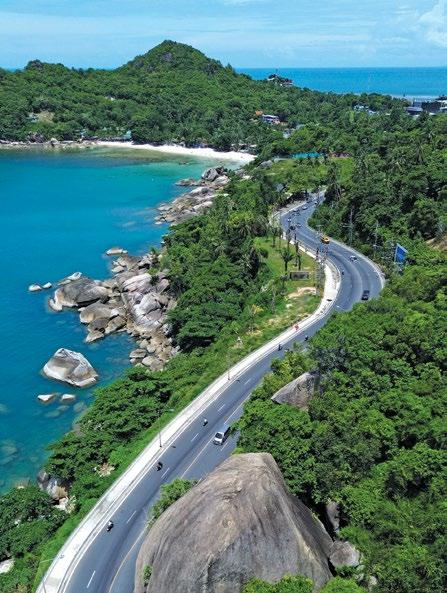
Temples are not merely places of worship on Koh Samui – they shape community life.
“Temples in Samui have always been more than religious sites,” says Siriwan Phongchababnapa, director of the Dipabhāvan Foundation. “They are the heart of the community, quietly guiding daily life, offering wisdom, and fostering unity.”
In earlier times, abbots often led development. “Decades ago, the abbot of Wat Lamai led villagers to carve a road through the jungle, connecting Lamai to Chaweng,” Siriwan recalls. “It was both a spiritual and social mission –people came together for the greater good.” This enduring connection between temple, home, and school formed a cultural triangle that continues to sustain Samui’s values across generations.
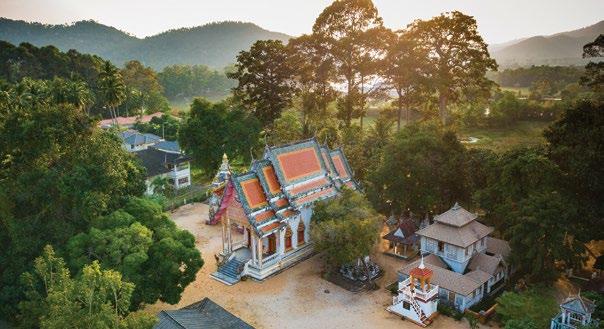
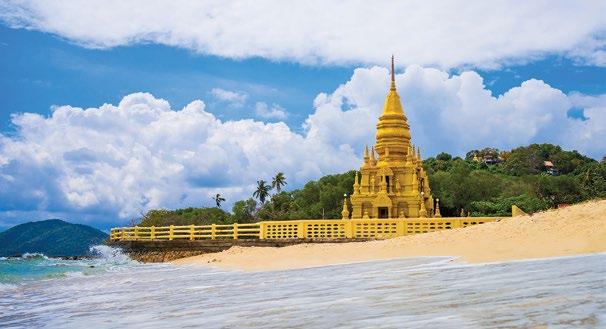


Scattered across the island are temples that embody Samui’s spiritual soul away from the crowds, yet close to the heart.
Wat Samret: One of Samui’s oldest temples, filled with over 200 years of quiet history. Inside, more than 70 Buddha statues delicately crafted





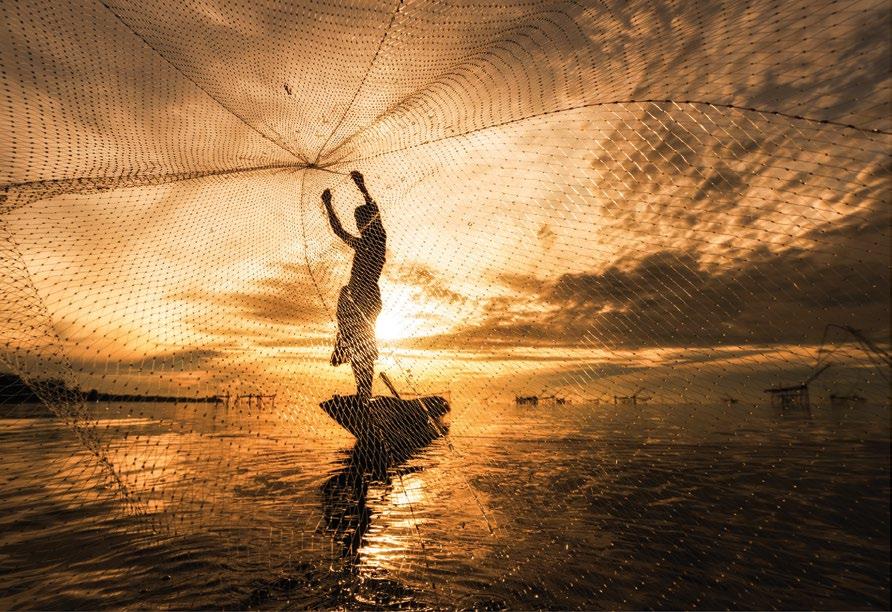
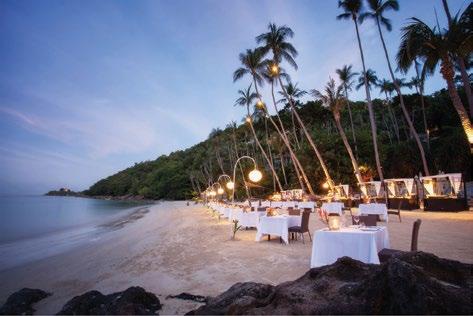

As twilight falls over the palm-fringed shores of Koh Samui, there’s magic in the air at Four Seasons Resort Koh Samui. The scent of sizzling seafood, the rhythm of traditional drums, the sparkle of candlelight. Island Nights are a spectacular celebration of Thai culture and coastal each week at the award-winning, Michelin-recognised restaurant, Koh Thai Kitchen and at
On Tuesday evenings, KOH Thai Kitchen presents Tam Rab Thai, a vibrant celebration of Thai culinary heritage. From live cooking stations and signature favourites like the Massaman Curry to regional favourites from across Thailand, each dish created by Chef de Cuisine Sumalee Khunpet and her team tells a story. Traditional entertainment and ocean views enhance the evening, creating a warm authentic atmosphere that
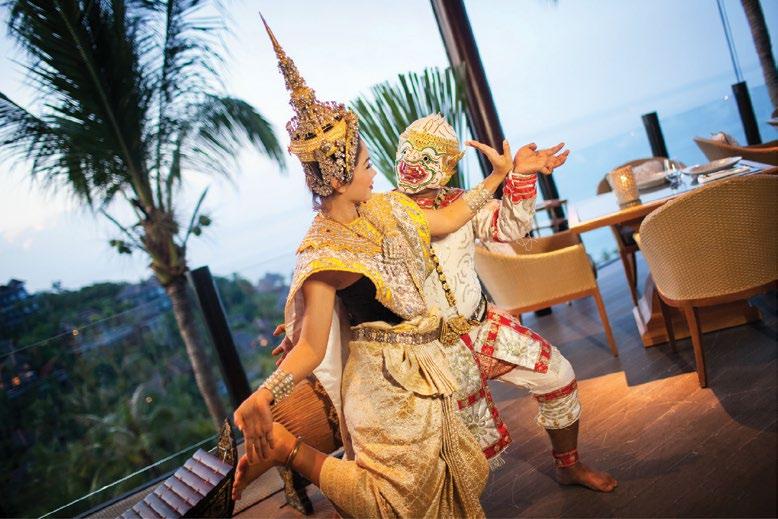
The Main Beach becomes the stage for Fisherman’s Night on Thursdays, where the simplicity of barefoot dining meets the drama Guests can enjoy a delectable beachside barbecue featuring the freshest seafood, premium meats, and local to life, echoing Koh Samui’s vibrant energy
Whether you are discovering the nuances of Thai cuisine or of the sea, these weekly dining experiences invite you savour each moment, and reconnect with the island’s natural beauty — and each other.

TUESDAYS AND THURSDAYS, 7:00 PM TO 10:00 PM.


Clockwise from Top Left Wat Sila Ngu’s striking red hall — a vibrant corner of Samui’s spiritual landscape
Wat Phra Yai — home to the island’s iconic Big Buddha
Dipabhāvan Meditation Centre — a serene refuge for mindfulness
The Chak Phra Festival — elaborate, sacred floats gather by the sea
A Manora dancer during Lah Pho Ta — an enduring Samui ritual
Wat Sila Ngu: Its sacred red sandstone glows at sunset, serving as a gathering point for both the devout and the curious. On weekends and Buddhist holy days, locals come together to chant and meditate. Its annual temple fair on April 24 is cherished as a celebration of faith, food, and community.
Wat Phra Yai: Crowned by the iconic golden Big Buddha, this is perhaps Samui’s most photographed spiritual site. The temple is a guardian, watching over the island’s transformation.
At Dipabhāvan Meditation Centre, nestled in the hills of Samui, nature and wisdom coexist in quiet harmony. Established in 2004 as a branch of the renowned Suan
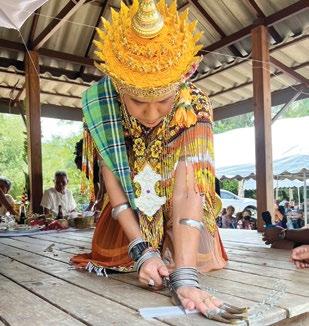

Mokkh International Dharma Hermitage, the centre offers meditation retreats throughout the year. “True Dhamma is seeing things as they are,” Siriwan explains. “When we understand suffering, we begin to cultivate peace, calm, and usefulness – for ourselves and for others.”
Spiritual life weaves gently through Samui’s daily rhythms and age-old ceremonies. At dawn, saffronrobed monks wander the Na Thon seafront and markets gathering alms, while evening brings the sound of chanting drifting softly


glide across land and sea, bearing Buddha images and blessings island wide.
The rare Loy Khro ritual, practiced in Baan Tai, sees bamboowoven boats floating on immature coconuts launched into the sea. These miniature vessels carry hair, nail clippings, and offerings, symbolically casting away misfortune






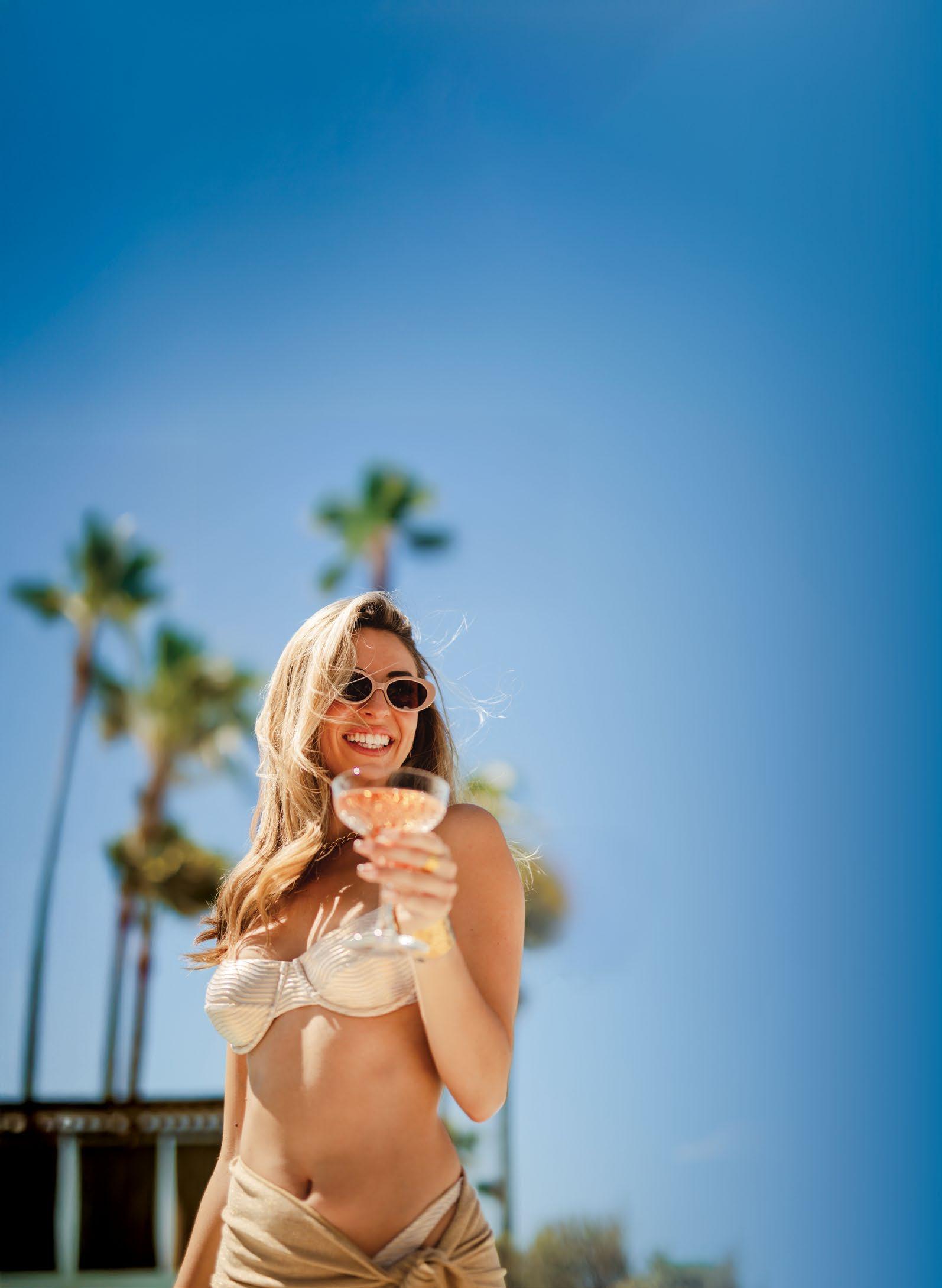



Venture beyond Samui’s main roads and the island gradually reveals its quieter soul – a tapestry of stories, salty air and timeless traditions. “Visitors come for the beaches, but they remember the stories,” says Nittharat. “There’s magic in the places that maps don’t shout about.”
Begin your journey in Lipa Noi, Taling Ngam, Thong Krut, and Bang Po – peaceful pockets where coconut groves stretch to the sea and fishermen still cast their nets by hand. In these villages, you’ll find not just scenery, but the spirit of Samui.
One such place is the community of Phang Ka, nestled in a serene bay on the island’s southwest tip. Amnat, the deputy mayor, highlights the historic Phang Ka Pier – a post-World War II relic built by Japanese forces to transport minerals. “It’s more than just a pier – it’s part of our history,” he explains. “Over the years, nature has softened it, and now it’s one of the most beautiful and peaceful spots to watch the sunset.”
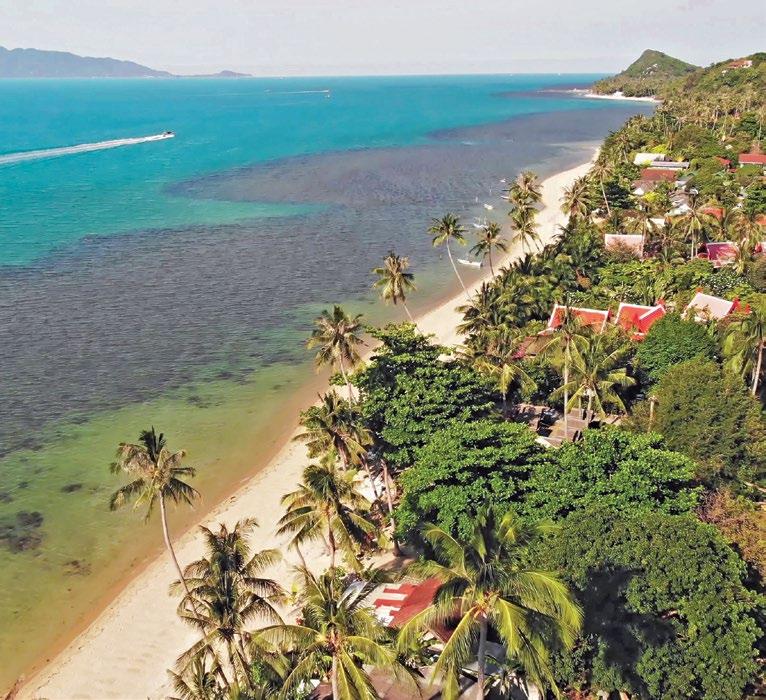
Today, Phang Ka remains a hidden gem, where time slows and golden light spills across quiet waters. Amnat envisions revitalising this historic site as part of a broader effort to preserve and share Samui’s lesser-known treasures.
Just offshore lies Koh Tan, a lush island where mangroves hum with rare medicinal plants and coral gardens beckon snorkellers. But there’s an eerie edge to its beauty. “Even dogs can’t survive here,”

says Samaporn Boonsa, a local whose ancestors were among Koh Tan island’s first coconut farmers. “The elders say it’s something in the air – magnetic currents or vibrations. One man tried to disprove it. His dog circled the hut and howled for days.”
Nearby, Koh Mudsum is









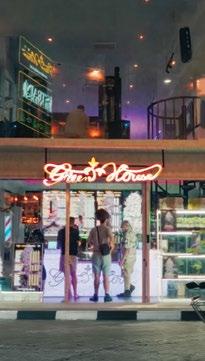







Clockwise from Top Left Guan Yu Shrine — a symbol of community and devotion
At Ang Thong National Marine Park you just might catch a Bruda whale gliding by
Hin Ta Hin Yai — nature’s cheeky landmark
Samui locals have long lived in harmony with nature
Elephants roam freely at the Elephant Kingdom Sanctuary — a haven for these gentle giants
dark sky, they heard the sound of a Javanese traditional flute and ancient drums drifting on the breeze,” says Samaporn. Once known for pearl farming, Mudsum now offers one of the island’s most breathtaking golden hour views.
Further offshore, Ang Thong National Marine Park offers the ultimate island-hopping adventure. Visitors can explore 42 emerald islets, hidden lagoons and cinematic cliffs.
Back on Samui, stroll to the Secret Buddha Garden, where moss-covered statues seem to whisper serenity. Just beyond lies the Coconut Heritage Trail at Baan Mapraow, where you can experience the art of organic

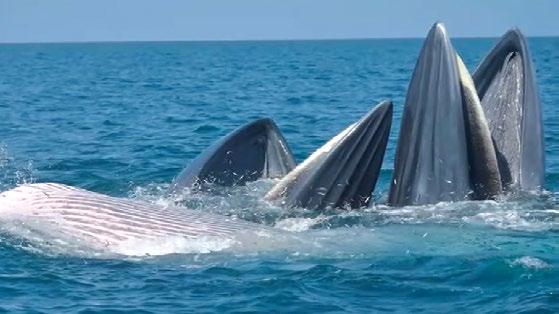
coconut cultivation – from planting and harvesting to making oil. This natural haven also offers delicious local desserts made from freshly harvested coconut.
Nearby, rescue elephants roam freely at one of Samui’s top attractions. “They love mangoes, hate the heat, and munch palm leaves which helps us recycle coconut waste,” smiles Panda, a caretaker at Elephant Kingdom Sanctuary. “Our sanctuary is built on three words: ethical, freedom and love.”
Just a short ride to the coast brings you to Hin Ta Hin Yai, strange rock formations said to house the spirits of a grandmother and grandfather lost at sea on a

mission to find a beautiful wife for their cherished son. “The wedding gifts he carried turned into the nearby islets,” says Nittharat.
End your exploration at Guan Yu Shrine, where Thailand’s tallest statue of the revered Chinese warrior towers 16 metres, a beacon of strength and devotion. The roots of this shrine run deep in Hua Thanon, one of Samui’s oldest Chinese-Hainanese settlements.
“The founder vowed to build it if his business thrived,” says Siriwan. “It did – and so did our faith.”
Today, the shrine stands as a proud symbol of cultural heritage and the community spirit that shaped the island’s soul.




“To understand Koh Samui, you have to taste it,” says Chef Santi Wongsawat, known to locals as Chef Aor, owner of Phensiri Restaurant, celebrated for its authentic local cuisine and sustainable approach.
“Back then, Samui was a land of coconut groves and fishing nets,” he recalls. “We didn’t have pig farms. Our protein came from the sea or backyard chickens. Buffalo meat? That was only for big village celebrations.”



Local ingredients helped carve the island’s identity. “Pla Sai [Sand whiting] was everywhere – our daily catch.” The island’s fruit trees offered seasonal treasures: Langsat, Durian, Mamud (a uniquely aromatic local mango), and Mamuang
Thaai Tor – a small, crisp native mango. “As a boy, I’d climb the trees and peel the skin off with my teeth,” he says. “You never forget that taste.”


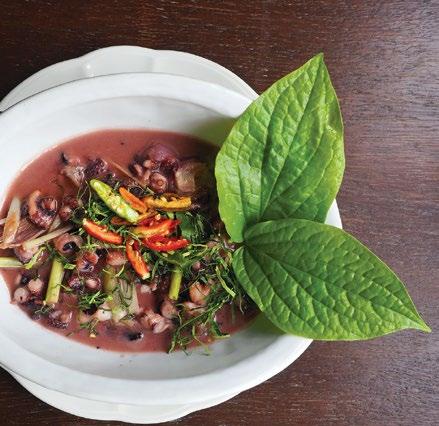

Some of Samui’s rarest dishes are kept alive in whispers carried across generations. Yam Rad Ley is a zesty salad made from a leaf found only on the island, tossed with raw fish and Kapi – fermented shrimp paste. Yam Kati Hoi Phuekan and Yam Kati Goong Chon Nam
Groi are spicy coconut salads with
delicately flavoured shellfish or shrimp found in Samui’s mangroves. “When monsoon season hit,” says Chef Aor, “we’d comb the beach at dawn for flying fish eggs caught in seaweed. We’d fry them in an omelette – salty, simple, unforgettable.”
Even squid has its own Samui spin. Tom Look Em is a bold broth made with bullet-sized baby squid. For Wai Khua, reef squid is gently simmered with coconut milk over coconut husk embers. “On Samui, coconut is more than an ingredient – it’s the root of our way of life,” he adds.
When the sun sets, Samui invites you to discover its wild and romantic side. The island’s nightlife is where world-class parties meet village warmth, and moonlight mingles with tradition.
From upscale beach clubs in Chaweng to beachfront gatherings in Bang Rak, Lipa Noi, and Lamai, Samui is fast emerging as Thailand’s premier party destination. International DJs, boutique music festivals, and luxury villa soirées have transformed the scene – but what truly sets Samui apart is its spirit.
“Back in the day, Samui people welcomed strangers like family,” says Nittharat. “That spirit is still alive – and it gives every event a different energy. Whether it’s Pride or a music festival, Samui celebrates with heart.”


As the gateway to Koh Phangan’s legendary Full Moon Party, Samui offers the best of both worlds – high-energy nightlife with a laid-back island vibe. “You can dance till dawn, then greet the morning with a coconut in hand, feet in the sand, and peace in your heart. That’s what makes us different,” Nittharat adds. Here, the party is more than music and lights. It’s about connection, celebration, and being welcomed – the “Very Samui” way.

Party vibes in Koh Samui: DJ beats, live music, and fire shows light up the island’s nights





Above
The sustainable, nature-friendly design of Samui International Airport — where travel meets island sensibility
Your Koh Samui adventure begins long before your feet touch the sand. Ranked among the most beautiful airports in the world, Samui Airport feels less like a terminal and more like a tropical resort.
Forget the sterile chill of conventional airports. Here, you’re greeted by open-air pavilions, thatched roofs, garden walkways, wooden swings, beanbags, and beach chairs – surrounded by warm island smiles. There’s no rush – only the gentle rhythm of Samui life.
Hand-built in the 1980s by local carpenters and artisans, the airport was crafted using traditional techniques and sustainable materials to create a gateway that truly reflects Samui. Even the departure lounge offers a final warming embrace: sundecks, garden views, and complimentary local snacks that feel like a farewell gift. Samui Airport is not just an entry point – it’s an introduction to the island’s spirit.
To truly know Samui is to look beyond its glossy surface and step into its living story – a story etched in children’s laughter during the rice harvest, in prayers whispered at dawn, in the rich taste of coconutlaced curries, and in the quiet pride of those who call the island home. Samui’s soul endures in the

harmony between past and present, in the resilience of its people, and in the gentle wisdom passed from one generation to the next.
Embark on a Very Samui journey – travel as presence, where roots matter more than routes. Here, there are no souvenirs, only stories you’ll carry home.
Samui is more than an escape, it extends an invitation – to listen, to learn, and to become part of its unfolding tale.
ISLAND WORDS TO KNOW
Dai (ด๋าย, pronounced ďāy) –Yes, can do
Mai Dai (ม่ายด๋าย, pronounced m̀āy ďāy) – No, cannot
Em (เอม, pronounced em) –Feeling full
Nuey Khao (เนือยข๋าว, pronounced neụ̄y k̄ȟāw) – Hungry
Roi / Hroi (หรอย, pronounced hrɔ̀i) – Delicious, flavourful
Jai Yen (ใจเย็น, pronounced t͡ɕaj˧yĕn) – Calm-hearted, composed


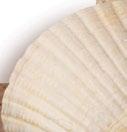
Words Pinanong Panchuen & Anutra Ungsuprasert

Photos Facebook page: HRH Princess Sirivannavari Nariratana Rajakanya, Queen Sirikit Museum of Textiles, Royal Thai Embassy, London UK, Seri Kantajai, Jim Thompson, and Shutterstock
‘Make them, and I will wear them’:
How Her Majesty Queen Sirikit turned humble weaves into global treasure


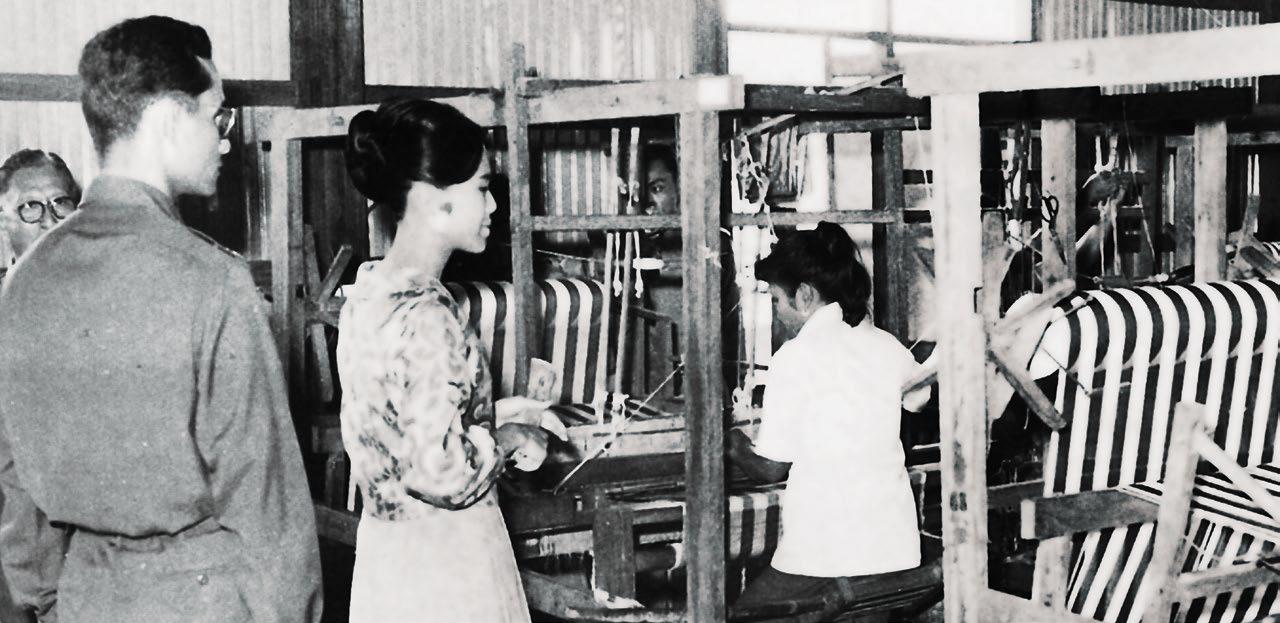
Thai silk is far more than an elegant textile – it is the beating heart of a centuries-old craft deeply intertwined with Thailand’s cultural identity. This lustrous fibre, with its intricate patterns and vibrant hues, embodies not just the dedication of skilled artisans but the enduring vision of Her Majesty Queen Sirikit The Queen Mother. Her lifelong commitment to preserving and promoting Thai silk has transformed this humble fabric into an internationally admired treasure – and one that continues to shape the nation’s creative spirit.
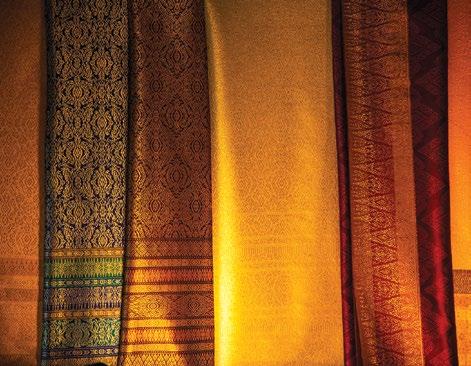
Long before Thai silk graced the world’s catwalks and royal wardrobes, it was a simple yet dignified part of everyday life in rural communities. Mudmee silk, or tie-dyed silk, has long been woven into sarongs and skirts by villagers in the Northeast. Each piece bears hallmarks unique to the local culture, with patterns often passed down from mother to daughter.
In 1970, during a visit to Nakhon Phanom province’s Na Wa district to meet flood victims,

Her Majesty Queen Sirikit noticed that the women welcoming her were wearing worn, yet beautiful mudmee silk skirts. “I told them their fabrics were beautiful and asked if they would weave them for the Queen,” she later recalled during an address to mark her 60th birthday in 2004.
“They replied, ‘Why would the Queen want these? Only poor people wear this’. I told them that if they wove them for the Queen, I would wear them all the time.”
This simple exchange sparked a revolution that transformed the


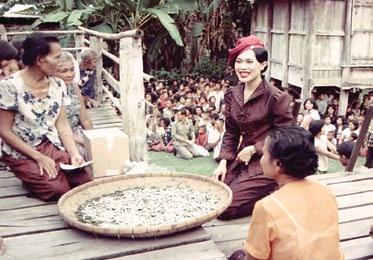

fortunes of silk weavers all across Thailand. Her Majesty’s vision –to combine cultural preservation with economic empowerment – led to the creation of the Foundation for the Promotion of Supplementary Occupations and Related Techniques of Her Majesty Queen Sirikit in 1976, better known as the SUPPORT Foundation.
By commissioning local weavers, paying them in advance, and wearing Thai silk garments herself, Her Majesty Queen Sirikit revealed the true value of this ancient craft and inspired a renaissance that continues to this day.
THE MOTHER OF THAI SILK
Her Majesty’s tireless support for rural communities and the revival
Above
HM Queen Sirikit’s dedication earned her the title “The Mother of Thai Silk”
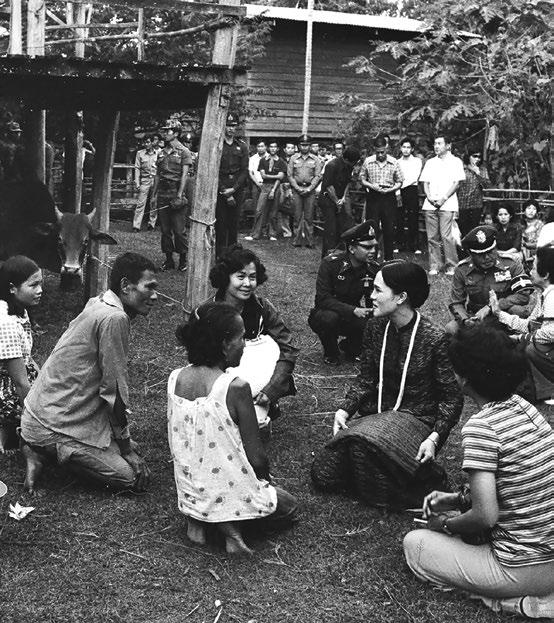
of ancient silk traditions earned her the affectionate title, “The Mother of Thai Silk”. Archaeologists have unearthed evidence that sericulture in Thailand dates back more than 4,000 years, with silk threads discovered alongside bronze bracelets in the prehistoric Ban Chiang culture. Yet, sericulture was only formalised during the reign of King Chulalongkorn (Rama V), who in 1902 invited Japanese experts to help develop the ancient Thai tradition and established the Department of Silk Weaving under the Ministry of Agriculture. However, these efforts dwindled after his reign.
It was not until HM Queen Sirikit intervened that the art of Thai silk flourished once more. Recognising
“They replied, ‘Why would the Queen want these? Only poor people wear this’. I told them that if they wove them for the Queen, I would wear them all the time,” HM Queen Sirikit recalled.

its cultural and economic importance, she spearheaded the creation of the Queen Sirikit Institute of Sericulture in 1976, ensuring that every stage – from mulberry cultivation and silkworm rearing to dyeing and weaving –was nurtured and protected. Her vision extended to preserving native Thai silk strains, natural dyeing methods, and traditional weaving patterns, ensuring a holistic approach to safeguarding this treasured heritage.
In 2012, the Thai people came together to honour Her Majesty on her 80th birthday, bestowing upon her the title “Mother of Thai Silk” in recognition of her extraordinary contributions to the preservation of Thai tradition.
THE QUEEN’S TIMELESS THREADS
A visit to the Queen Sirikit Museum of Textiles, nestled within the Grand Palace compound in Bangkok, reveals the profound legacy of Her Majesty’s vision. The museum’s collection of royal costumes is a glistening testament to the enduring beauty and versatility of Thai silk.
Clockwise from Top Left HM Queen Sirikit oversaw the renaissance of Thai silk
The latest exhibition “Decades of Style: The Royal Wardrobe of Her Majesty Queen Sirikit” at the Queen Sirikit Museum of Textiles, Bangkok
“Chud Thai Through the Ages” — an exhibition of Thai traditional dress held during London Craft Week 2025
Clockwise from Far Right In London, HRH Princess Sirivannavari presents “The Evolution of Chud Thai and the Timeless Craft of Thai Textiles” at “Chud Thai Through the Ages” during London Craft Week 2025
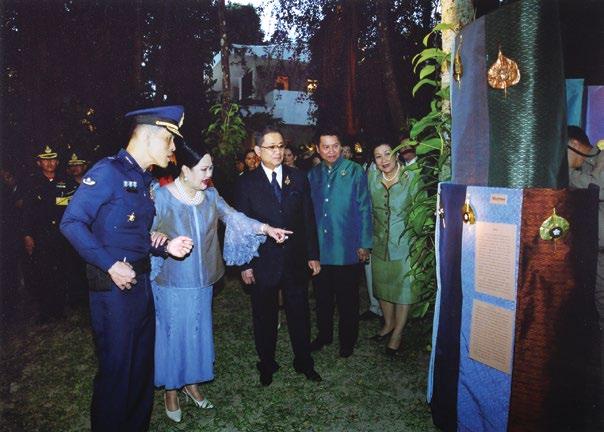
Curator Alisa Saisavetvaree notes that younger visitors, who never witnessed Her Majesty’s royal appearances firsthand, are often struck by the elegance and sophistication of the costumes on display.
“They are stunned by how beautiful traditional Thai dress can be,” Alisa explains, “and they leave inspired to incorporate Thai textiles into modern fashion, jewellery, and design.”
The museum’s latest exhibition, “Decades of Style: The Royal Wardrobe of Her Majesty Queen Sirikit”, celebrates Her Majesty’s 90 th birthday with a stunning array of ensembles that span the decades. Each garment tells the story of craftsmanship and creativity, interweaving Western influences with traditional Thai design. Curated under the guidance of Her Royal Highness Princess

Sirivannavari Nariratana Rajakanya – the museum’s chief curator –the exhibition celebrates not just the Queen Mother’s legacy but the shining future of Thai textile arts. Princess Sirivannavari, a designer and cultural ambassador in her own right, has taken up the thread of her grandmother’s mission. She champions homegrown textiles through initiatives like “Fun with Thai Fabric”, encouraging designers and artisans to innovate while staying true to their roots. In London, she presented the keynote talk “The Evolution of Chud Thai and the Timeless Craft of Thai Textiles” at “Chud Thai Through the Ages” – an exhibition of Thai traditional dress held during London Craft Week 2025, marking 170 years of Thai-UK diplomatic relations.
The Queen Sirikit Museum of Textiles stands as a beacon of Thai heritage conservation. Every piece in its collection undergoes meticulous documentation and, if necessary, deep-freeze sterilisation to remove any trace of mould or pests before going on display. Fragile items are carefully assessed and, where required, delicately restored to preserve their integrity. The museum’s commitment to conservation ensures that each thread, each motif, and each story is protected for future generations to admire.

HRH Princess Sirivannavari, a designer and cultural ambassador in her own right, has taken up the thread of her grandmother’s mission.







HM Queen Sirikit’s vision has inspired countless individuals to become ambassadors of Thai silk in their own right. One such figure is Seri Kantajai, founder of the WTH Academy and an advocate for Surin silk from the East of Thailand. His passion was born not of privilege but of adversity: after being fooled into buying fake silk online, he refused to abandon his interest. Instead, he created the Facebook group “Love Surin Silk”, an online community dedicated to sharing and safeguarding the art of Surin silk.
In this digital gathering space, weavers, collectors, and enthusiasts share stories, showcase new patterns, and discuss the craft’s challenges and triumphs – though buying and selling are strictly prohibited. Seri’s journey with Surin silk began over a decade ago when he volunteered with the Surin Tourism Promotion Association. There, he discovered a community of weavers who still use centuriesold techniques to produce their exquisite silk.


“Every time I wear Thai silk,” Seri shares, “I think of the labour and love that go into each piece – from planting mulberries and raising silkworms to the final weave. It’s more than just fabric –it’s a legacy.”



Top A collection of HM Queen Sirikit’s wardrobe on display at the Queen Sirikit Museum of Textiles
Above & Left
Seri Kantajai, Surin Cultural Ambassador 2021, and his silk collection
Opposite, Clockwise from Top Exterior of the Queen Sirikit Museum of Textiles
Weaving silk: heart, art, and craft
The Royal Court Textiles of Siam Exhibition runs until April 2027 in Galleries 3-4 at the Queen Sirikit Museum of Textiles

What began as occasional accessories – a scarf, shawl, or even sarong – has now become his everyday attire. He discovered that silk is not only luxurious but also practical: warm in winter, cool in summer, and surprisingly easy to care for.
“Wash it gently or with a little shampoo – silk is protein, like hair,” he advises. “Dry it briefly in the shade, and a hot iron will smooth it perfectly. Interestingly, naturally dyed silk grows more vibrant each time it is worn and washed.”
His passion inspired guided cultural trips along Surin’s Silk Road, where he dresses the part, seamlessly blending heritage with contemporary style. In recognition of his efforts, the eastern province’s tourism association named him Surin Cultural Ambassador in 2021.











Another maestro of modern Thai silk is Vichada “Dao” Sitakalin, Creative Director of home textiles for the famed Jim Thompson marque. Initially trained in interior design at the Rhode Island School of Design, her perspective was transformed when she witnessed the entire production process at Jim Thompson – from silkworm farming and dyeing to weaving.
“Before, I only thought of silk as a design element,” she explains. “But seeing the dedication at every stage made me appreciate its true value.”
In May, Jim Thompson hosted its design and commercial teams from London and the US at its Pak Thong Chai factory. “They were amazed to see how complex the process is,” Dao recalls. “When they went home, they could tell customers exactly why Thai silk is so valuable – every thread has a story.”

From Top Left: Vichada “Dao” Sitakalin, Jim Thompson’s Creative Director of home textiles
Thai silk is more than a design element — it brings history and elegance to home furnishings
“Before, I only thought of silk as a design element,” Vichada explains. “But seeing the dedication at every stage made me appreciate its true value.”
A visit to the Queen Sirikit Museum of Textiles cemented that impression. “They told me, ‘Your queen is truly the global ambassador of Thai silk.’ Every royal gown is timeless.”
Dao sums it up perfectly: “Her Majesty devoted her life to creating something of immense value for Thailand. It’s our duty as designers to honour that legacy – to preserve and adapt it for new generations.”
The story of Thai silk is, ultimately, the story of Thailand itself: a tale of resilience, creativity, and
community. From the mudmee skirts of Na Wa’s villagers to the glittering halls of the Grand Palace, every thread is woven with pride. Under the guidance of Her Majesty Queen Sirikit The Queen Mother, what was once humble homespun fabric has become a global emblem of Thai identity.
As Her Majesty herself once said, “If they wove them for the Queen, I would wear them all the time.” Today, that spirit lives on in every piece of silk, in every weaver’s hands, and in every Thai heart that cherishes this precious legacy.
Words Phoowadon Duangmee Photos Shutterstock
Soft rain drips from banana leaves, mist clings to hills, and frogs serenade the twilight in lush green fields – a beautiful symphony that signals Thailand’s monsoon.
The green season shifts the spotlight from sundrenched beaches to quiet rejuvenation, as the country slows down, breathes deeply, and blooms afresh. From May through September, the landscape bursts into vivid greens, mist envelops ancient temples, and waterfalls swell into thunderous cascades. With fewer travellers on the trail, a quieter and greener Thailand emerges – revealing a soulful side where nature and culture intertwine in endlessly fascinating ways.

Discover the hidden gems and quiet wonders of Thailand’s soulful rainy season

Rainforest Queen
Contrary to its reputation for inconvenience, the rainy season rewards those who embrace it with gentle solitude and a deep sense of renewal.
Tourist throngs thin, prices soften, and the rhythm of travel shifts from frenetic sightseeing to mindful discovery. Rather than rushing through packed itineraries, visitors find beautiful places to linger – immersed in rain-kissed rice paddies, mist-wreathed mountain farms, and serene coastal refuges. The rains awaken the senses, travel becomes more intimate, and the landscape more like an old friend.
Thailand unfurls as a land of transformation during monsoon – when hidden gems glow brightest beneath a gentle, persistent rain.
Here’s a guide to where to go and what to do as you chase the clouds.
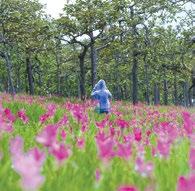
From late June to August, Chaiyaphum province unveils one of Thailand’s most captivating landscapes. Pink and purple Siam tulips (Dok Krajiew) blanket the highlands of Pa Hin Ngam and Sai Thong national parks. A sea of mist swirls through the surreal sandstone formations at Pa Hin Ngam, adding to their dreamlike mystery. The air is crisp and refreshing.
About an hour’s drive north of Pa Hin Ngam, Sai Thong National Park offers tranquil tulip meadows leading to stunning cliffside nooks with panoramic views of cloud-covered valleys. Nearby, Tat Ton Waterfall cascades powerfully through lush forest, resplendent at the monsoon’s peak. Together, these sites showcase Chaiyaphum’s unique mix of floral beauty and geological wonders.

Firefly Evenings Adventure and wonder go hand in hand as the rains glisten in Prachinburi province.
Just a short ride from Bangkok, the Kaeng Hin Phoeng rapids in Khao Yai National Park come alive from June to October, offering some of Thailand’s most exhilarating rafting. Here, swollen jungle streams twist through dramatic
boulders and lush greenery, making for an unforgettable paddle through the wild. As day turns to night, the rushing currents give way to a quieter magic. In Prachinburi’s Mueang district, the firefly forest at the 2 nd Artillery Regiment glows with a galaxy of flickering lights from June to July, creating a fleeting, fairytale spectacle.
Surrounded by dense foliage, the gentle pulse of these tiny creatures transforms the dark into a shimmering constellation. From rafting through rain-fed rapids to witnessing the quiet poetry of fireflies, Prachinburi is at its most enchanting when water rules the landscape.

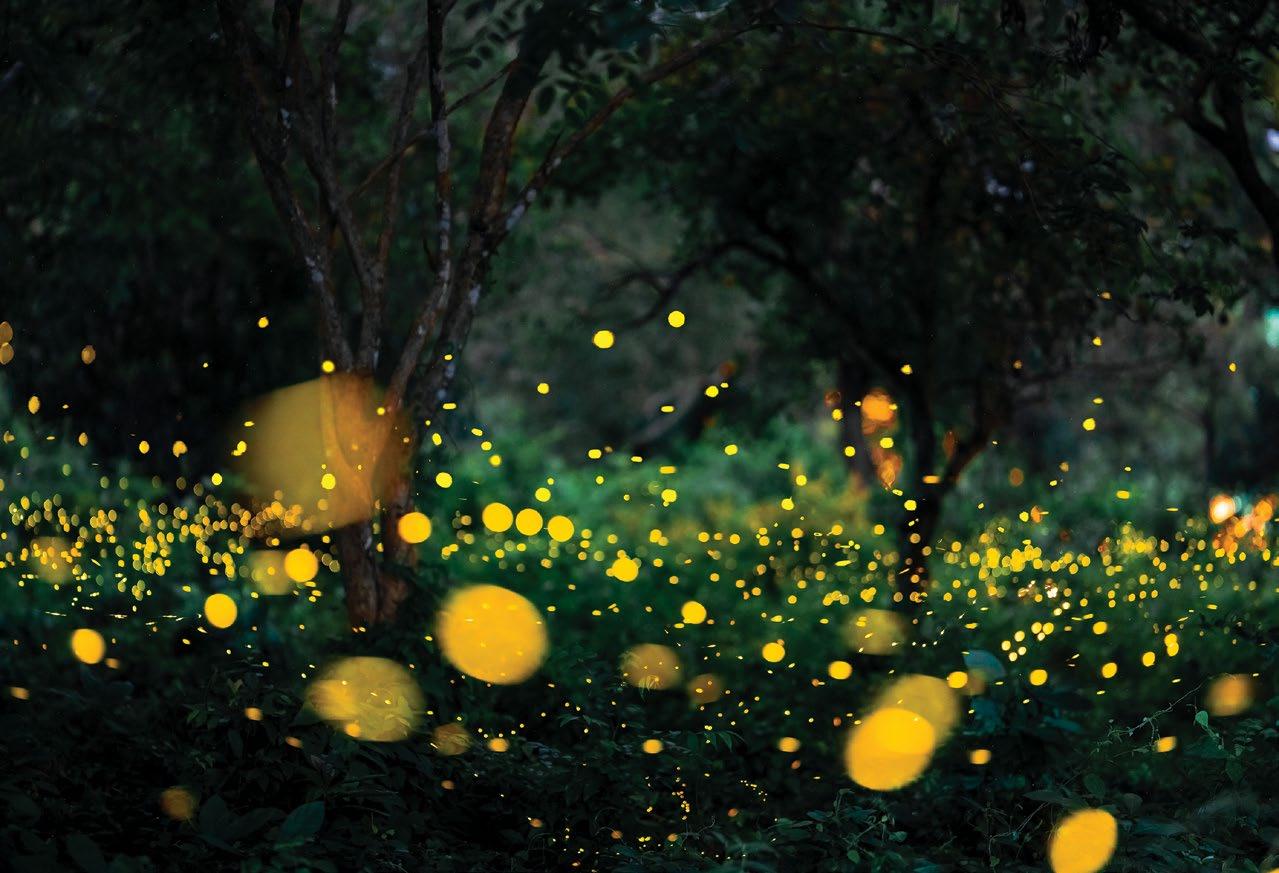

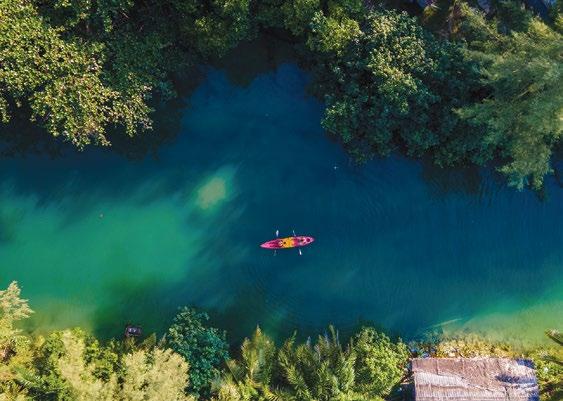
KOH CHANG, TRAT
Wild, Wet & Wonderful
Koh Chang in Thailand’s Trat province transforms into a lush, tranquil escape where tropical showers breathe new life into waterfalls, jungles, and beaches. Trails through the island’s verdant interior lead to beautiful waterfalls like Klong Nonsi and Than Mayom. Kayaking through the mangroves of Salak Khok offers you an intimate connection with nature, as fireflies light up the waterways at dusk. While rougher seas may limit some marine activities, snorkelling around sheltered coves and nearby islands like Koh Wai is still possible between showers. Adventurous souls can explore quiet fishing villages by scooter or enjoy the solitude of rain-soaked beaches. The early wet season leaves eastern islands like Koh Chang beautifully green yet relatively dry – perfect for hammocking, spa days, and relaxed beach strolls.


KRABI
Limestone Romance
Krabi’s quieter season hides striking secrets. Gone are the crowds and cruise boats – what remains is a natural paradise being reborn. Rain nourishes the land, cloaking limestone cliffs in mist and awakening waterfalls that tumble with renewed energy. It’s both a wilder and gentler time to explore. Begin your adventure with a hike up Khao Ngon Nak Mountain. Climb above the swirling clouds for panoramic views across forest and sea – ethereal, fleeting, and
magical. Down in the lowlands, the Klong Thom Hot Springs offers a contrasting warmth: mineral-rich pools carved into the rock, nestled in dense jungle, where steam mingles with falling rain. Glide silently through Ao Thalane’s mangrove channels by kayak, watching kingfishers dart and dripping leaves shimmer in a thousand shades of green. Or seek solitude along the rain-washed sands of Tup Kaek and Klong Muang beaches.
PAI, MAE HONG SON
Mist-Shrouded Terraces
When the rains arrive, Pai valley dons a lush green cloak – calling to nature lovers and thrill-seekers alike. The rain breathes new life into the valley, refreshing Pai Canyon’s dramatic cliffs and trails, now draped in mist. Waterfalls like Mo Paeng and Pam Bok surge with power, offering natural swimming in a tropical jungle. Nearby, the Tha Pai Hot Springs provide
soothing warmth surrounded by rain-soaked forest. Trekking through terraced rice fields and rolling hills leads you to hidden villages and sweeping mountain vistas. Seeking thrills? Try bamboo rafting on the Pai River, and float by farmland and vibrant greenery for close encounters with wild beauty. Don’t miss the famed Land Split gorge and its organic farms bursting with rain-fed crops.



Rivers, Rails & Rainfall
Kanchanaburi in the rainy season is raw and cinematic – a scene full of adventures. Erawan and Huay Mae Khamin waterfalls gush in vivid glory, their turquoise pools perfect for cooling off mid-hike. In Sai Yok National Park, kayaking and bamboo rafting along the River Kwai become quiet thrills beneath forested cliffs draped with mist. This is also the best time to walk the historic Hellfire Pass trail, where soft rain and jungle sounds heighten the emotional gravity. For animal lovers, ethical sanctuaries like Elephant Haven offer intimate, mudsplashed encounters with rescued elephants in a natural setting. Between downpours, take the slow train over the famed Death Railway – windows open to sweeping river and jungle views.




UBON RATCHATHANI
Slow Time on the Mekong
The rains recharge Ubon Ratchathani’s rice paddies, forests, and waterfalls, painting the landscape in vibrant green. This is an ideal time for peaceful exploration. Pha Taem National Park offers ancient cliff paintings and misty views over the Mekong River, while waterfalls like Huay Luang surge with renewed power. Scenic boat rides and tranquil riverside walks reveal the dramatic beauty of the rain-fed Mekong. Nature lovers will find thriving birdlife and jungle trails bursting with wildflowers. The season also deepens the province’s spiritual vibe, especially during the Candle Festival, when monks begin their three-month rains retreat in quiet reflection.


Green Quietude
In northern Thailand’s Nan province, the rainy season clothes Pua district in a thousand shades of green. Just 60 kilometres from the town centre, misty hills cradle rice paddies that shimmer with rain, and time slows to nature’s rhythm. At Sila Phet Farmer School Homestay, travellers bed down in traditional wooden houses surrounded by emerald paddy fields. Mornings begin with birdsong and mist, and days unfold with slow adventures – cycling through the paddies, learning to grow
rice, and swimming beneath the now-roaring Sila Phet Waterfall. Meals are freshly prepared and home-cooked, from rich Hang Lay curry to tasty Nam Phrik Num (green chilli dip) and garden-picked steamed vegetables. Nearby, Nan’s cultural heritage awaits: Wat Phumin, famed for its romantic “Whisper of Love” mural, offers a glimpse into the region’s heart, while Wat Nong Bua and Wat Ton Laeng showcase the quiet beauty of Tai Lue architecture. In Nan, rain isn’t a season – it’s a way of life.





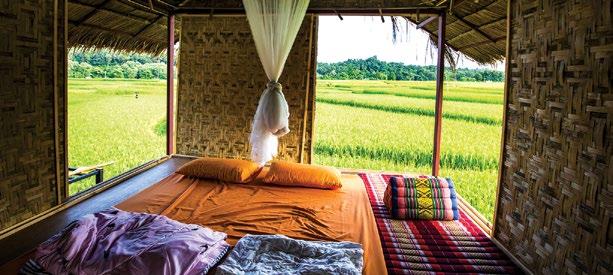
RANONG
Steam, Storms & the Sea
The monsoon breathes new life into Ranong, turning Thailand’s rainiest province into a soul-soothing green retreat. The rains amplify every element on the Andaman coast – jungles release their heady scent, waterfalls surge, and hot springs simmer with dreamy allure. At Raksa Warin Hot Springs, ancient banyan trees shade open-air pools steaming at 65°C, their sulphur-free waters favoured by locals for generations. During the rains, steam curls skyward as raindrops dance on the surface, weaving spa tranquillity with rainforest magic. For a wilder soak, head to the hills and Porn Rang Hot Spring, where thermal waters bubble beside a mountain brook immersed in birdsong. The season also unlocks Ranong’s adventurous side: kayak through the mangrove-rich Laem Son Biosphere Reserve, hike the grassy slopes of Phu Khao Ya, or witness storm-cleansed sunsets over Bang Ben Beach. In Ranong, the rain doesn’t interrupt – it invites you to dive deeper into nature’s rhythms.


Rapids, Rice, and Roots
From June to October, Chiang Mai province overflows with both thrills and tranquillity. Kick off your adventure on the Mae Taeng River, where a two-hour rafting trip sweeps down through 14 rapids, from gentle Class II runs to adrenaline-pumping Class V drops. After a wild ride on the river, the pace slows under the rain clouds of Chiang Mai’s green mountain valleys. In Mae Chaem district, terraced rice paddies form giant steps beneath Doi Inthanon’s misty peak. Stroll around the small temples and rice paddies while listening out for the gossip of local women gathered around wooden looms. Mae Chaem is known for producing some of Thailand’s finest handwoven textiles.
To the north, Chiang Dao district’s tranquil forested mountains and scenic trails lead to temples, hot springs, and herbal saunas. On the western slopes of Chiang Dao Mountain, Mueang Kong is known by

young travellers as a paradise on earth, where friendly farmers invite rainy-season visitors to share their serene rice paddies, clear creeks, warm home-cooked meals, and rustic farmsteads.
Rainy season travel in Thailand isn’t about enduring the weather – it’s about embracing a gentler and more intimate rhythm. As monsoon rains sweep across the land, nature responds with lush abundance and quiet beauty. Mist softens the mountains, forests breathe, rivers swell, and hidden places stir to life. Fewer crowds, softer light, and the warm hospitality of locals lend a rare intimacy to the journey. This is a time to linger rather than rush, to listen as much as look, and to feel connected – to the land, the season, and yourself. In the hush between rains, Thailand reveals a soulful magic that shines brightest when the clouds roll in.
With the right mindset, travelling during rainy season can be magical. Pack light, waterproof gear like a foldable rain jacket, dry bags, and a compact umbrella. Opt for quickdry footwear to handle splashes and spills, and maintain a flexible itinerary in case of sudden downpours. Starting the day early is advisable, as mornings are usually drier. If you’re heading into the jungle, insect repellent and leech socks are essential. Stay hydrated – the humidity can sneak up on you. Most importantly, be cautious around waterfalls and rivers after rain, as flash floods can occur even when it’s not raining nearby. If you’re well prepared, the rainy season offers lush scenery, fewer crowds, and memorable adventures.
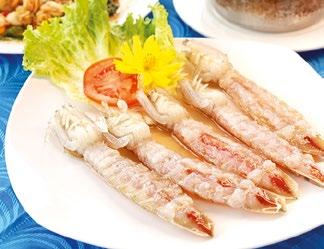



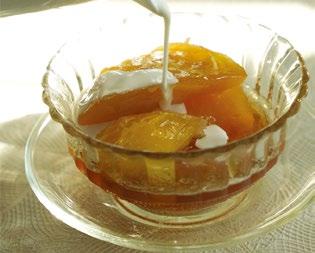

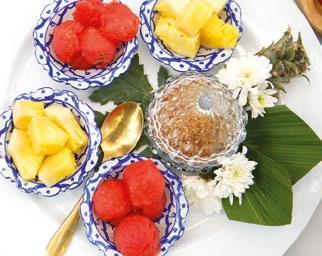
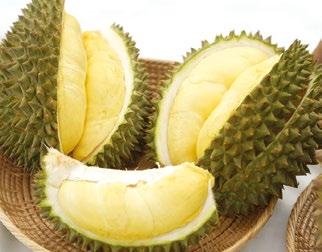

















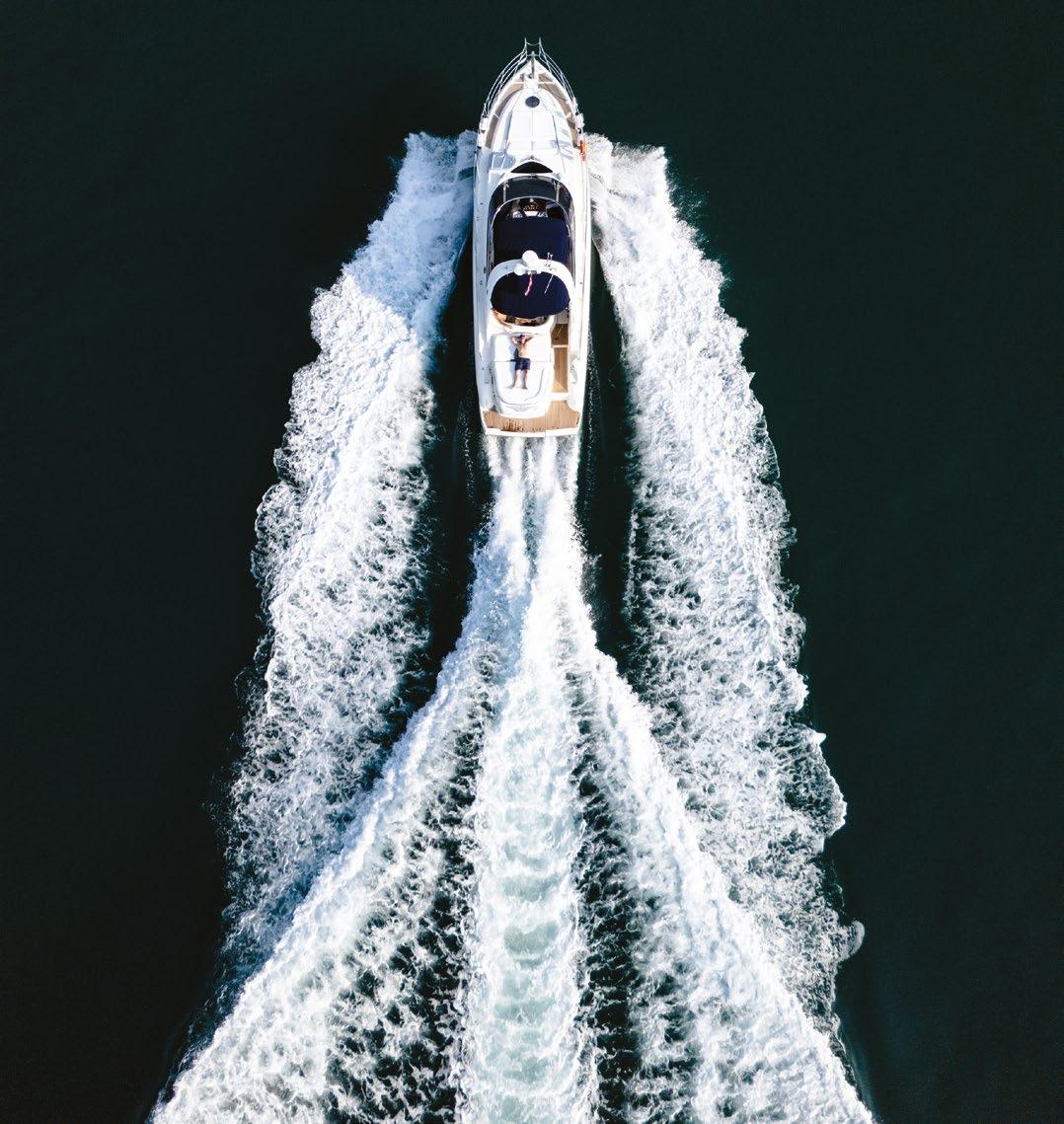
Hooked on the twists and turns of The White Lotus Season 3?
Anantara Lawana Koh Samui Resort has just the treat to feed your addiction. The “Glimpse of White Lotus” package invites you to step into the series in the most delicious ways.

The indulgence begins at The Singing Bird Lounge, featured in the Season 3 premiere episode, where Chloe and Chelsea enjoyed drinks at the bar scene. Choose the Anantara White Lotus Mirage for a creative concoction of jasmine tea-infused gin, Campari and calamansi juice; the Mook to invoke Lisa Blackpink’s character with a zesty mix of tequila, orange liqueur, cranberry and lime; or the Gaitok – Lisa’s suitor distilled into a smoky combo of mezcal, lychee liqueur, coconut, and pandan syrup.


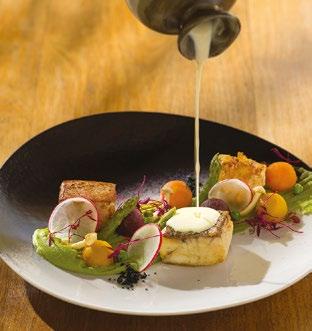



a personalised keepsake and a thoughtful gift to take home.
Next comes an exquisite eight-course dinner at Tree Tops Signature Dining, where bold flavours are served in your own private cocoon nestled high in the canopy. Guests also receive
Koh Samui comes alive with colour, creativity and purpose in August as Tembo Art & Style returns for its third edition. Hosted at the Tembo Beach Club & Resort, this annual gathering has become a popular rendezvous for creatives near and far.
Over three days, guests can explore self-expression, immerse themselves in stunning exhibitions, browse an artisan market and enjoy live performances that pulse with island spirit. Two showcases anchor the event: the Tembo TRASHion Show transforms trash into couture designs on Saturday, August 16, while the Fabulous Tembo Fashion Show celebrates diversity and self-expression with models of all shapes, ages, and nations on the following day.
Tembo’s focus on inclusiveness and community means participation is free, though guests are encouraged to give back through Tembo Cares –an initiative supporting local causes like the Save Elephant Foundation. August 15-17, 23/2 Bangrak Beach, Moo 4, Bophut, Koh Samui, Surat Thani, www.tembo-samui.com




The resort offers the option of combining this dining experience with a sunset cruise on a luxury yacht. Perfect if you like your drama shaken, stirred and served with a view.
Anantara Lawana Koh Samui Resort, 92/1 Moo 2, Bophut, Koh Samui, Surat Thani, www.treetopsrestaurantsamui.com/ glimpse-of-white-lotus
If you’re itching for some hands-on holiday fun, stop by at De Lamun Art & Workshop –where imaginations run wild and paintbrushes feel like magic wands. Open to both adults and smaller artists, this charming spot invites you to dive into its signature workshops, ranging from art therapy-inspired painting sessions to aromatic candle-making.
De Lamun also offers a custom candlemaking service for those looking to create unique gifts, event favours or keepsakes, and even offers mobile workshops for private celebrations or corporate events.
Guided by the belief that art can heal and empower regardless of your age or skill, De Lamun transforms each workshop into a mini wellness ritual, helping you tune in, zone out, and leave with something unique and beautiful. 151/62, Bophut, Koh Samui, Surat Thani, www.instagram.com/de_lamunworkshop
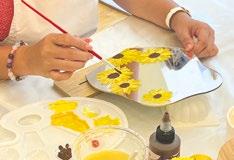





Digital nomads might consider the Nomad Brunch their Samui headquarters. Located in a lush, laid-back corner of the island, this café with minimalist rustic interior is thoughtfully designed with remote workers in mind.
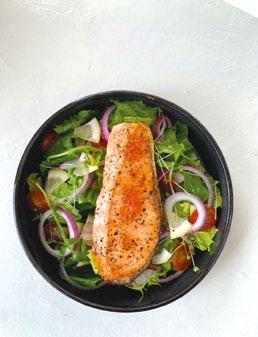
The atmosphere is calm and cosy with warm lighting, mellow beats and seating that invites you to linger and get creative. Whether you’re up against a tight deadline or dreaming up your next big idea, this space is designed to get you in the zone.
Keep your energy up with an all-day brunch menu that’s comforting, satisfying and scrumptious. The upgraded American Fried Rice comes with golden fried chicken, sausage, and rice wearing a glistening ketchup-y glaze. Or choose to Design-YourOwn Breakfast, with eggs just the way you like them. Alternatively, you can just sit back with a great cup of coffee in a hangout that hits all the right notes. 24/76 M.5 Bophut, Koh Samui, Surat Thani, www.instagram.com/ nomad_kohsamui

From the cool mountains of Chiang Mai to the sun-kissed shores of Samui, two culinary worlds collide in delicious harmony at “Chiang Mai to Samui – A celebration of flavours and local finds”. For two nights, Chef Wai of Chiang Mai’s Michelin Bib-awarded Rasik Local Kitchen will join Chef Banana of FishHouse Restaurant & Bar at Kimpton Kitalay Samui to meld the soulful depth of northern Thai cuisine with the vibrant freshness of southern island fare.
Think Surat Thani oysters, curry leaves, amber leaves, and sea purslane, all woven seamlessly into dishes like Isaan-style Oyster Tartare on Rice Crisps, Young Tamarind Leaf Fritters with Crab, a bold

Northern-style Seafood Laab, and a playful Thai Tiramisu with Chiang Mai cacao nibs. Each bite offers a journey through Thailand’s landscape.
On August 13, guests are invited to indulge in a 12-course extravaganza followed by a smaller eight-course feast the following day. Both sharingstyle banquets will be served at the beachfront FishHouse Restaurant & Bar. August 13-14, Kimpton Kitalay Samui, 10/79
Moo 5 Bophut, Choeng Mon Beach, Koh Samui, Surat Thani, www.kimptonkitalaysamui.com
Waterspeak Scuba offers more than dives in Samui’s turquoise waters – it invites adventurers on a journey of deep discovery. This full-service PADI dive and bespoke charter centre specialises in expeditions tailored for groups who want to explore Thailand’s marine treasures on their own terms.

Whether you’re a seasoned diver or dipping your fins for the first time, the expert guides and instructors ensure your time beneath the waves is both safe and stunning. Uncover secluded snorkelling spots, vibrant coral reefs and coves around Samui – with detours available to the underwater wonderlands of Koh Tao, Koh Phangan and the alluring Ang Thong National Marine Park. With Waterspeak Scuba, every dive unfolds a deeper story. Sunset Resort 33/110, Bangrak, Koh Samui, Surat Thani, www.thewaterspeak.com


Tucked under a lush forest canopy overlooking an emerald river in sleepy northern Phuket, Kin Dee is a hidden gem. This awardwinning family restaurant serves Thai favourites along with rare dishes seldom found elsewhere. Start with the fiery shrimp Nam Phrik dip, a local delicacy packed with Phuket prawns, lime, and shallots and served with an exotic veggie medley starring sea grapes and young cashew leaves. Or dive into the


Boasting a stunning hillside location above Kata Noi Beach, The Sundeck is south Phuket’s new favourite bar for golden hour. Offering frontrow seats for fiery skies and gorgeous sea views, this breezy hangout serves up a Mediterranean-Thai mashup menu that swings from sangria and wood-fired pizza to zingy Thai classics. Whether you’re in the mood for a lazy, boozy brunch, sundowners, or a starlit feast with friends, The Sundeck delivers. The fantastic food comes with an irresistible vibe courtesy of hypnotic Lounge and House beats spinning into the night. 228 Koktanod Rd, Karon, Mueang Phuket district, Phuket, thesundeckphuket.com




Tamarind Shrimp, hidden beneath a mountain of fried garlic and shallots. Prefer turf over surf? Try the stir-fried duck with basil and kaffir lime – it might just steal your heart.
71/6 Tambon Mai Khao, Thalang district, Phuket, www.facebook.com/ kindeethailand2009
Tucked away on lively Soi Rommanee in Old Town Phuket, Batik Banyan is a chic temple to the art of batik. This fashion haven offers a curated collection of clothes and accessories, each handcrafted with the intricate wax-and-dye technique that defines batik. Couture garments for both




men and women infuse Phuket’s cultural heritage with modern flair, creating unique style statements.
Whether you’re a fashion enthusiast, culture lover or both, Batik Banyan captures the island’s soul in every stitch. 4 Soi Rommanee, Talat Yai, Mueang Phuket district, Phuket; www.facebook.com/batikbanyan
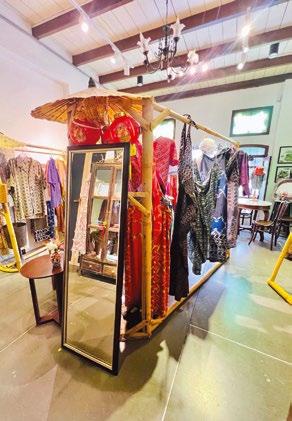


Saddle up for an unforgettable adventure with Horse Riding Phuket by Khun Cowboy and transform Bang Tao Beach into your very own prairie. Whether you’re a first-timer, seasoned rider, child or adult, their guided tours offer beachside fun with a splash of magic – how about riding through the surf, Hollywood blockbuster-style?
Well-cared-for horses and professional handlers ensure every ride is not only safe, but truly memorable. This exciting alternative to ordinary beach activities is also a treasure trove of photo opportunities. Give free rein to romance by riding with your partner, or maybe even pop the question – nothing says “forever” like a sunset ride in the waves. North of Catch Beach Club on Bang Tao Beach; Facebook: Horse Riding Phuket by Khun Cowboy

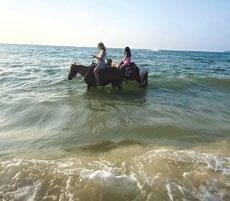



It’s an eternal question for foodies: does the perfect pizza exist? The truth is, pizza perfection lies in the tastebuds of the beholder. But in Phuket, one unassuming spot comes pretty close. Introducing Agli Amici, a cosy joint where two brothers from Italy have been crafting wood-oven masterpieces for over a decade. This place oozes neighbourhood charm –


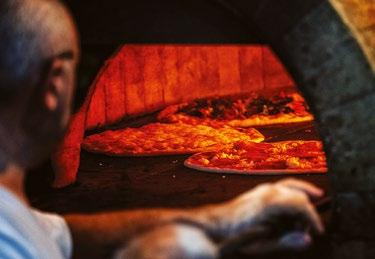
think warm smiles, family-vibes and consistently great pizzas with a variety of generous fresh toppings. Customers also love the range of sizes, perfect for solo dining or a feast with friends. 40/24 Chao Fah Tawan Tok Rd, Chalong, Mueang Phuket district, Phuket; www.facebook.com/agliamici.phuket
The Olympics of grappling comes to Phuket this August, as the world’s best submission artists battle for a coveted world title. Since its inception in 1998, the Abu Dhabi Combat Club (ADCC) Submission Fighting World Championship has set the gold standard for international submission grappling. This world-class tournament brings together top-tier athletes from a variety of disciplines, including Brazilian jiu-jitsu, wrestling, judo, sambo and catch wrestling.
With divisions for men, women and youth, spanning beginner to professional levels, the ADCC World Championship invites grapplers from all corners of the globe to compete. Best of all, spectators can attend for free and experience world-class submission grappling up close. August 2; Central Floresta Mini-Convention Hall, Phuket; Instagram: @adccth



Just a short drive from popular Krabi hotspots like Ao Phra Nang and Noppharat Thara Beach lies Ban Na Tin, a humble community famed for its traditional way of life rooted in farming and fishing. Visitors here can borrow a bike and explore scenic rubber plantations and coconut groves set against lush mountains, while those with more time
can book a homestay to bask in the simple living, southernThai style. Villagers also offer workshops on coconut-shell crafting, batik-making, and even raising sheep, while early risers can join local fishermen and help bring in the morning catch.
12 Moo 4, Tambon Ao Nang, Mueang Krabi district, Krabi; www.facebook.com/Baannateen






Start your day with a Chinese-Southern fusion breakfast in the wooden pavilion or beneath swaying bamboo trees at the Ginn Dimsum Cafe. Feast on a Dim Sum banquet with your coffee and tea, or opt for popular local options like fish congee, Bak Kut The (pork soup), Steamed Stuffed Squid, Salted Egg Yolk Buns, Baked Shrimp with Glass Noodles, or Steamed Pork with Salted Eggs. Looking for something heartier? The café also offers Chinese Rolled Noodle Soup, Fried Vietnamese & Chinese Sausage with Rice, Marinated Pork and Salted Egg Yolk with Rice, Crispy Pork Rice, and Egg Noodles with Roast Pork. 238/44 Maharaj Rd, Tambon Pak Nam, Mueang Krabi district, Krabi, www.facebook.com/ginn.dimsum.cafe

Forget the stress of city life and grab a berth at The Boat Coffee Cafe & Restaurant for stunning views of the setting sun over the Gulf of Thailand. This cute Klong Muang Beach establishment sits in a row of wooden cottages surrounded by a lush tropical garden, serving a mix of traditional southern Thai and Western-style dishes.
Tuck into delectable Grilled Giant Tiger Prawns with spicy dipping sauce, Steamed Dog Conch, Stir-fried Crab in Black Pepper, or Fresh Oysters with a spicy Thai dip. Klong Muang Beach, Krabi, Facebook: The Boat Coffee Cafe & Restaurant


MICHELIN’S
Boutique eatery Krua Laew Tae R-Rom jumped into the national spotlight this year when the Michelin Guide Thailand was extended to cover Chon Buri.
Tucked away in Pattaya’s Soi Yume neighbourhood, the all-white restaurant creates its menu around what local fishermen bring to shore every morning. The catch is transformed into delicious dishes using homemade curry pastes and flavourings –think Triggerfish Red Curry, and crab, shrimp, clams and fresh fish sizzling on the grill. For a succulent turf-based option, try the signature Sour Beef Curry.


However, the delectable offerings at reasonable prices mean the restaurant is almost always full. Diners are advised to reserve a table at least one week in advance. Soi Yume, Pattaya, Chon Buri; Google Maps: Krua Laew Tae R-Rom
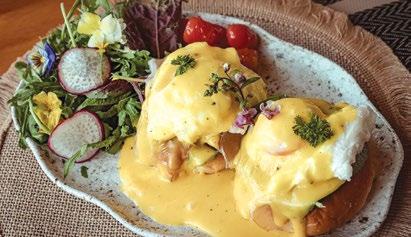


Worked up an appetite frolicking in the sea? Satisfaction comes guaranteed at Tastory Pearl Beach Koh Chang – a simple yet chic café with a sumptuous menu and views to match. Recharge your batteries with their delicious range of authentic pizzas, or opt for something more local like Barbecued Pork Ribs, Pineapple Fried Rice, Satay or Spring Rolls. For something lighter, choose from a lip-smacking range of coffee and beverages paired with delectable homemade cakes and pastries. Pearl Beach, Koh Chang, Trat; www.facebook.com/Tastory.Pearl.beach.kohchang

SPOTLIGHT
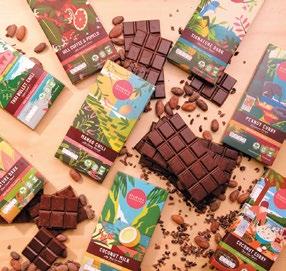
Charlie and the Chocolate Factory comes alive as you walk through the gates of Siamaya Chocolate – an eye-catching café that draws cocoa addicts from all corners of the globe. Siamaya Chocolate has become one of Thailand’s largest craft chocolate makers since opening its distinctive redand-white doors on Tha PaeWua Lai Road in 2017. Locally sourced cocoa is fashioned
into delectable and unique creations with an emphasis on sustainability and ecofriendliness. The vast choice of confections on offer range from 70% dark chocolate to Thai tea-flavoured and durian milk chocolate. Fancy something a bit different? Try the Khao Soi, Coconut Curry, or Tom Yum flavoured chocolate bars. Tha Pae-Wua Lai Road, Chiang Mai, siamayachocolate.com




The trio of chefs behind neon-lit legend Charmgang and the more intimate Thai wineand-dine spot Charmkrung is now offering a fresh culinary twist at Charmkok.
Located in Bangkok’s artsy Talat Noi neighbourhood, Charmkok serves beloved lunch staples like Khanom Jeen (curry rice noodles) and savoury crispy noodles from 11am to 3pm before transforming into a lively bistro bar from 5pm. The menu changes in the evening to focus on bolder and richer flavours – think Som Tam or Phanaeng Nuea (creamy beef-coconut curry) –that zing when paired with the expertly crafted cocktails and local brews. A perfect place to celebrate and make connections. 880 Charoen Krung Rd, Talat Noi; www.instagram.com/charmkok

MIXOLOGY IN MOTION
Award-winning mixologist Supawit “Palm” Muttarattana is shaking things up with the latest sensation on Bangkok’s bar scene –Dry Wave Cocktail Studio.
Distilling two decades of mixing experience, Palm has taken classic cocktails and added fresh twists to entice modern palates. The Old Fashioned is fused with 1980s favourite Cosmopolitan to create “1806-1988”, while a mash-up of Mezcal Margarita and Breakfast Martini gives birth to Morning Tijuana. A décor inspired by trees and ocean waves lends a welcoming warmth, enhanced by the genre-blending soundtrack of everything from disco to nu-funk.
Seeking a cocktail adventure helmed by one of Asia’s most celebrated mixologists? Head to Thonglor and ride the Dry Wave. 2/F, SODALITY Thonglor 13, Bangkok; www.instagram.com/drywavecocktailstudio

Chocoholics rejoice! Swiss chocolatier Läderach has finally made it to Thailand to serve up its world-famous FrischSchoggi, or fresh chocolate with premium nuts and fruits. The prestigious brand also offers an indulgent array of pralines, truffles, and chocolate-covered treats.

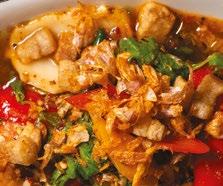
Made using bean-to-bar craftsmanship, each confection reflects a commitment to freshness, purity, and quality. Läderach’s


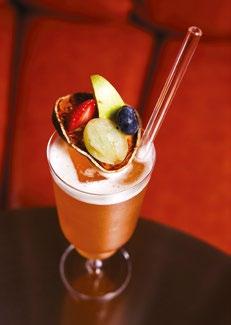
artisanal ethos is also mirrored in the store’s elegant and modern design. Thailand is fast becoming a key market for luxury confections as interest in high-quality chocolate grows. The arrival of Läderach now brings Thai consumers a taste of some of the world’s finest handcrafted chocolates – freshly made and now just steps away. M/F, The EmQuartier, 695 Sukhumvit Rd; thai.laderach.com





Fine dining meets natural wonders at The Halia in Singapore’s lush Botanic Gardens. This charming eatery offers stunning views of the surrounding UNESCO Heritage Site. Perfect for a refreshing drink or a satisfying meal while exploring the sprawling gardens, The Halia also deserves its reputation as an outstanding standalone fine-dining destination.
The menu caters to a wide range of tastes, offering weekday breakfasts and lunches, as well as weekend brunch and dinner. Standout dishes include the tangy Chilli Crab Spaghettini and the BBQ Pulled Beef Dip with bread and prawn crackers. 1 Cluny Rd, Ginger Garden, Singapore Botanic Gardens; www.thehalia.com



The Stallery is marking its 10th anniversary with “Artifice” – a groundbreaking solo exhibition by Hong Kong-based artist CHANG (Ernest Chang). Known for his signature vivid colours and intricate linework, CHANG shifts boldly to conceptual exploration and sculpture in his latest show.
Founded a decade ago, The Stallery has played a key role in Hong Kong’s contemporary art scene, providing a space for new ideas, creative risk-taking and evolving artistic expressions. This exhibition embodies the gallery’s continued support for Hong Kong’s dynamic art community, solidifying its position as a leading force in the city’s creative landscape. Until August 31; G/F, 82A Stone Nullah Lane, Wan Chai, Hong Kong; www.thestallery.com


JRR Tolkien’s epic The Lord of the Rings stands as one of the most compelling trilogies in literature, captivating audiences in print, films and even stage adaptations. This August, Singapore hosts the highly-anticipated Asia debut of “The Lord of the Rings – A Musical Tale” at Marina Bay Sands. Dive into the magical world of Middle-Earth, where hobbits, dwarves, wizards and elves come to life through dazzling theatrics and captivating live music. August 12-31; tickets from S$68; Sands Theatre, Marina Bay Sands; www.marinabaysands.com/entertainment/ shows/the-lord-of-the-rings




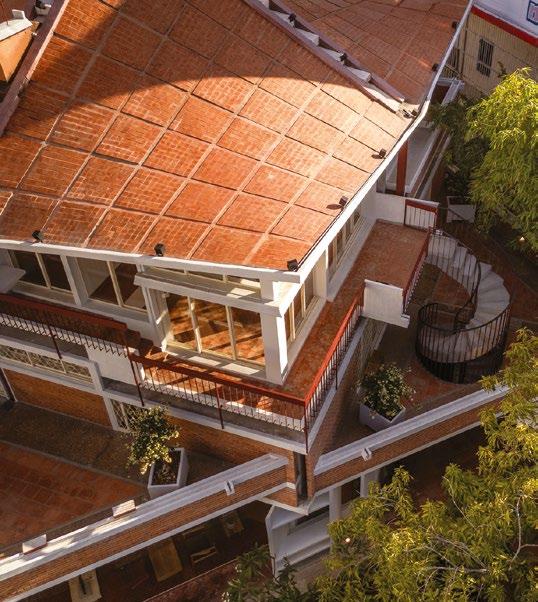
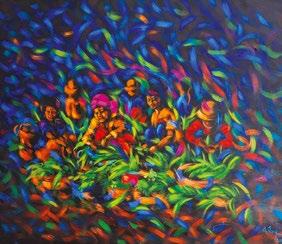
Art Meets Food brings together the worlds of culinary artistry and creative expression in an immersive, interactive exhibition. Helmed by celebrated Cambodian painter Nou Sary and renowned chef Sothea Seng, this journey through visual art and gastronomy offers a feast for both the eyes and tastebuds.



The former home of the father of Cambodian architecture, Vann Molyvann, has been transformed into Brown Coffee’s flagship store, seamlessly merging Khmer architectural heritage with contemporary coffee culture.
The café honours Molyvann’s legacy, blending thoughtful design with a welcoming, communityfocused atmosphere. Featuring


Sary’s expansive and vibrant works are complemented by inventive dishes crafted by Chef Sothea, widely recognised as one of Cambodia’s leading culinary figures. Together they invite visitors to engage in art and food in bold, unexpected ways. Until August 15; Vattanac Capital Tower, 66 Monivong Boulevard, Sangkat Wat Phnom, Phnom Penh, www.rosewoodhotels.com

original drawings, architectural models and an archival room open by appointment, the space stands as a living tribute to Cambodia’s design heritage and its dynamic, modern identity. Delicious brews are an added bonus. Brown Coffee and Bakery Mao Tse Toung, Vann Molyvann House, Phnom Penh; www.browncoffee.com.kh
Discover a lost civilisation hidden in the jungle of Siem Reap at The Hidden Temple Escape Room. This immersive experience plunges visitors into an ancient city packed with legends, cryptic puzzles and secret chambers. Teams must solve riddles, decode symbols and uncover buried secrets to lift a powerful curse before time runs out. Ideal for families, friends or team-building, The Hidden Temple blends suspense, collaboration and adrenaline in a race against time. Whether you are an experienced escape room fan or a curious first-timer, prepare for a journey that’s fun, challenging and unforgettable. 155 Wat Bo Road, Siem Reap; Open Sunday-Thursday: 9am-8pm; Friday: 9am12pm: Closed on Saturdays; www.escapegamesiemreap.com



The serene Nam Khan River bursts into colour and commotion one day a year as Luang Prabang’s much-loved Boat Racing Festival takes to the water. On race day, sleek longboats slice through the current powered by village crews paddling in perfect unison – a thrilling spectacle of speed, rhythm and raw energy.
The action spills over into a celebration of Lao culture and

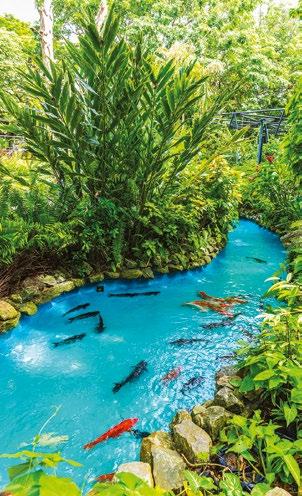
community pride, with riverside stalls showcasing local delicacies and crafts as live traditional music sets the festive tempo. Whether you’re cheering on the racers from the riverbank or tucking into fresh grilled fish, the Boat Racing Festival offers a front-row seat to Luang Prabang’s beating heart. August 23, Nam Khan River, Luang Prabang; www.tourismlaos.org

Behind its famed crystalline waters and powdery white sands, the Maldives hides a lush secret: havens of tranquil greenery. Sultan Park in the heart of the capital, Malé, occupies the grounds of the former Royal Palace and offers a serene retreat for locals and travellers alike.
Located close to the iconic Islamic Centre, this public park boasts manicured gardens, a serene fishpond, a children’s playground, and regular cultural events ranging from art exhibitions to live music. As night falls, illuminated fountains cast a magical glow, transforming the space into an enchanting oasis. Whether you’re seeking quiet reflection, family-friendly fun, or a window into Maldivian history, Sultan Park is an unbeatable destination.
5GH6+2C2, Malé, Maldives; Open daily: 6am-9.30pm.


Independence Day in the Maldives sparks celebrations across the islands on July 26, as locals unite with pride to mark their liberation from British rule in 1965.
The day begins with a presidential address, followed by a grand parade featuring the Maldives National Defence Force, students and cultural performers. Traditional Boduberu drumming and dance breathe life into the festivities, showcasing the country’s vibrant heritage.
City streets and buildings glow with flags and colourful lights while fireworks light up the night sky. Local fairs, sporting events and charity drives bring communities together. Resorts join the festivities with spectacular firework displays, making Independence Day a celebration for all. July 26, across Maldives




Bangkok Airways has once again brought international recognition to Thailand, winning two prestigious honours at the SKYTRAX World Airline Awards 2025: World’s Best Regional Airline and Best Regional Airline in Asia. This marks the 9 th consecutive year the airline has received both accolades. The award ceremony took place during the Paris Air Show at Paris-Le Bourget Airport, France.
Dubbed the Oscars of the aviation industry, the SKYTRAX awards are globally respected, with winners selected according to passenger satisfaction surveys from 350 airlines worldwide.
The continuing awards success reflects Bangkok Airways’ unwavering commitment to delivering an exceptional travel experience through its boutique airline – featuring thoughtfully curated in-flight meals, exclusive lounge services for all passengers, and a route network connecting cultural and key tourist destinations across the region.
Mr. Puttipong PrasarttongOsoth, President of Bangkok Airways, stated: “These esteemed awards are a testament to the dedication and hard work of our entire team. I sincerely thank our passengers for their continued trust and support, voting us once again as both the World’s Best Regional Airline and the Best Regional Airline in Asia. We remain committed to enhancing our service excellence while pursuing sustainable growth through a range of initiatives and projects.”

ริ เม นูอาหา ริ บนเค ริื�องและใน ห ้อง ริับ ริ อง ที ริังส ริริค ์อ ย ่าง พ ถึ พ ถึัน ริ วมถึ งเ ส ้นทาง บิน ที�เ ช่�อมโยง
เ ม่ อง วัฒน ธีริริ มและแห ล ่ง ท ่องเ ที�ยว ส าคัญ
ในภูู ม ภู าค นาย พ ฒิพง ศ ป ริ าสาททองโอส ถึ ก ริริ มกา ริผู้อ า นวยกา ริ ให ญ สายกา ริบิน บางกอกแอ ริ ์เว ย ์ส ก ล ่าว ว ่า “ ริ าง วัล อัน
ท ริ งเ กีย ริ ติิ นี�เ ป ็นเค ริื�อง ย่ น ยันถึ งความ

Bangkok Airways Public Company Limited and PTT Oil and Retail Business Public Company Limited (OR) signed a Letter of Intent (LOI) on May 9, to cooperate on the use of locally produced Sustainable Aviation Fuel (SAF) – a first for Thailand. The fuel will be used for Bangkok Airways flights, supporting both companies’ sustainability goals while guiding Thailand’s aviation sector towards an environmentally friendly future.
Present at the signing ceremony were Mr. Dechit Chareonwong, Bangkok Airways’ Senior Vice President of Operations, and Mr. Chaipruet Watchareecupt, OR’s Vice President for Aviation and Marine Marketing. The ceremony was held at Bangkok Airways headquarters on Vibhavadi Rangsit Road.
Mr. Dechit said that this partnership marked a major milestone for Bangkok Airways and its “Low Carbon Skies” campaign, aimed at reducing carbon emissions across all operations. He noted that it also laid foundations
for broader adoption of biofuels in Thailand’s aviation sector, aligning with the International Air Transport Association (IATA)’s goal of achieving carbon neutrality by 2050.
Mr. Chaipruet said the collaboration brings together OR, Thailand’s leading aviation fuel distributor, and Bangkok Airways, in using SAF produced by PTT Global Chemical (GC), a subsidiary of PTT Group. The SAF is produced via GC’s innovative co-processing technology – a first in the Thai aviation industry – and reflects OR’s commitment to supporting Thailand’s goal of achieving net-zero greenhouse gas emissions by 2065.
The LOI signals a shared commitment to sustainable practices in Thailand’s aviation sector, marking a critical step forward in clean energy development and an environmentally responsible future for Thai aviation. Explore Bangkok Airways’ sustainability initiatives at www.bangkokair.com/ sustainable-development

‘Trat Discovery: Islands and Beyond’ invites passengers to unlock discounts, unique experiences, and the chance to win free flights
The Tourism Authority of Thailand (TAT), in collaboration with Bangkok Airways and partners, has launched the “Trat Discovery: Islands and Beyond” campaign to promote travel in the East of Thailand. Running from May 1 to August 20, the campaign offers exclusive perks for Bangkok Airways passengers – though general travellers can also participate.
TAT Governor Ms. Thapanee Kiatphaibool notes that short holiday and weekend getaways in small groups are popular among Thai travellers. Thanks to its easy access by car, bus, or plane from Bangkok, the Eastern region – especially Trat and Chanthaburi – is an ideal destination, offering Instagrammable scenery, delicious local cuisine, and unique experiences.
Trat boasts island gems like Koh Chang, Koh Kood and Koh Mak, famed for water-based activities, fresh seafood, and delicious fruit such as Koh Chang Chanee durian and golden Trat pineapple. Nearby, Chanthaburi tempts visitors with a rich culinary heritage and unique local produce, earning it the title of Thailand’s Creative City of Gastronomy.
Part of the Amazing Thailand Grand Tourism and Sports Year 2025, the Trat
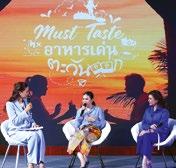


Discovery campaign spotlights “5 Must Do’s” in the East, including Must Taste, Must Try, Must Buy, Must Seek, and Must See.
Ms. Plernpis Kosolutasarn, Director – Tourism Associate and Partnership at Bangkok Airways, emphasised the diverse travel experiences in the East – from island adventures and red hawk watching to sunset boat rides.
Travellers can enjoy perks at dozens of Trat cafés, restaurants, and hotels with a Bangkok Airways boarding pass, FlyerBonus membership, or by scanning a QR code. Those spending at least 200 baht can enter a lucky draw for 10 pairs of domestic flight tickets, with winners announced on September 1 via Facebook and Instagram: @TratDiscovery.
Check out how you can participate in this campaign via Facebook and Instagram: @TratDiscovery.
Discovery: Island and Beyond”
Amazing Thailand
Grand Tourism and Sports Year 2025 และ
ุดขาย “5 Must Do In Thailand”
Must Taste, Must Try, Must Buy, Must Seek และ Must See

Bangkok Airways Public Company Limited participated in the 2025 Annual Meeting of the Bangkok Local Interline Reservations Group on May 6. In attendance were executives and representatives from reservations, ticketing and ground-operations departments of various international carriers, including Air Astana, Air China, ANA, Emirates, Etihad, EVA Air, Gulf Air, Hong Kong Airlines, Lufthansa, Malaysia Airlines, Oman Air, Philippine Airlines and Qatar Airways, to name a few. Global Distribution System providers in Thailand were also present.
The meeting was presided over by Mr. Sakesunt Panit, Qatar Airways Thailand’s Sales Operations Officer, in his capacity as Group President, and Mrs. Rattha Rujikiatkamchon, Director of Customer Service at Bangkok Airways, who serves as the Group Secretary. A special lecture was also delivered by Mr. Cholathit Suthiklom, Head of the Civil Aviation Authority of Thailand’s Consumer Protection Division.
Air Astana, Air China, All Nippon Airways, Bangkok Airways, Emirates, Etihad Airways, EVA Air, Gulf Air, Hong Kong Airlines, Lufthansa, Malaysia Airlines, Oman Air, Philippine Airlines, Qatar Airways























Khao Sok National Park is blooming with a thousand natural wonders as the green season arrives in Surat Thani province. Limestone cliffs rise from seas of mist, rainforests teem with life, and the Cheow Lan Lake shimmers silver in the breeze. This is the ideal time to drift
lazily in a longtail boat, spot hornbills in the trees, or trek to waterfalls fringed by wild ginger flowers. Just two hours from Surat Thani Airport, Khao Sok immerses visitors in nature – whether trekking through the jungle or chilling in a floating bungalow.

